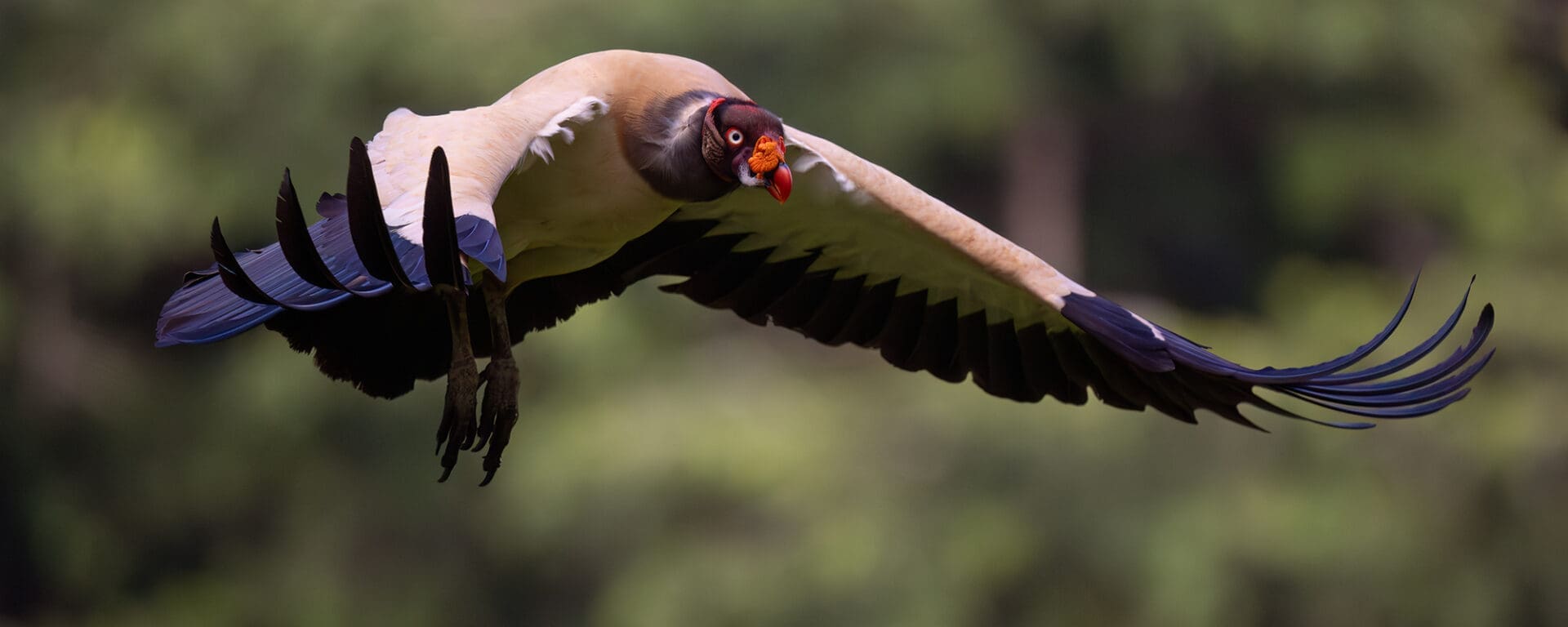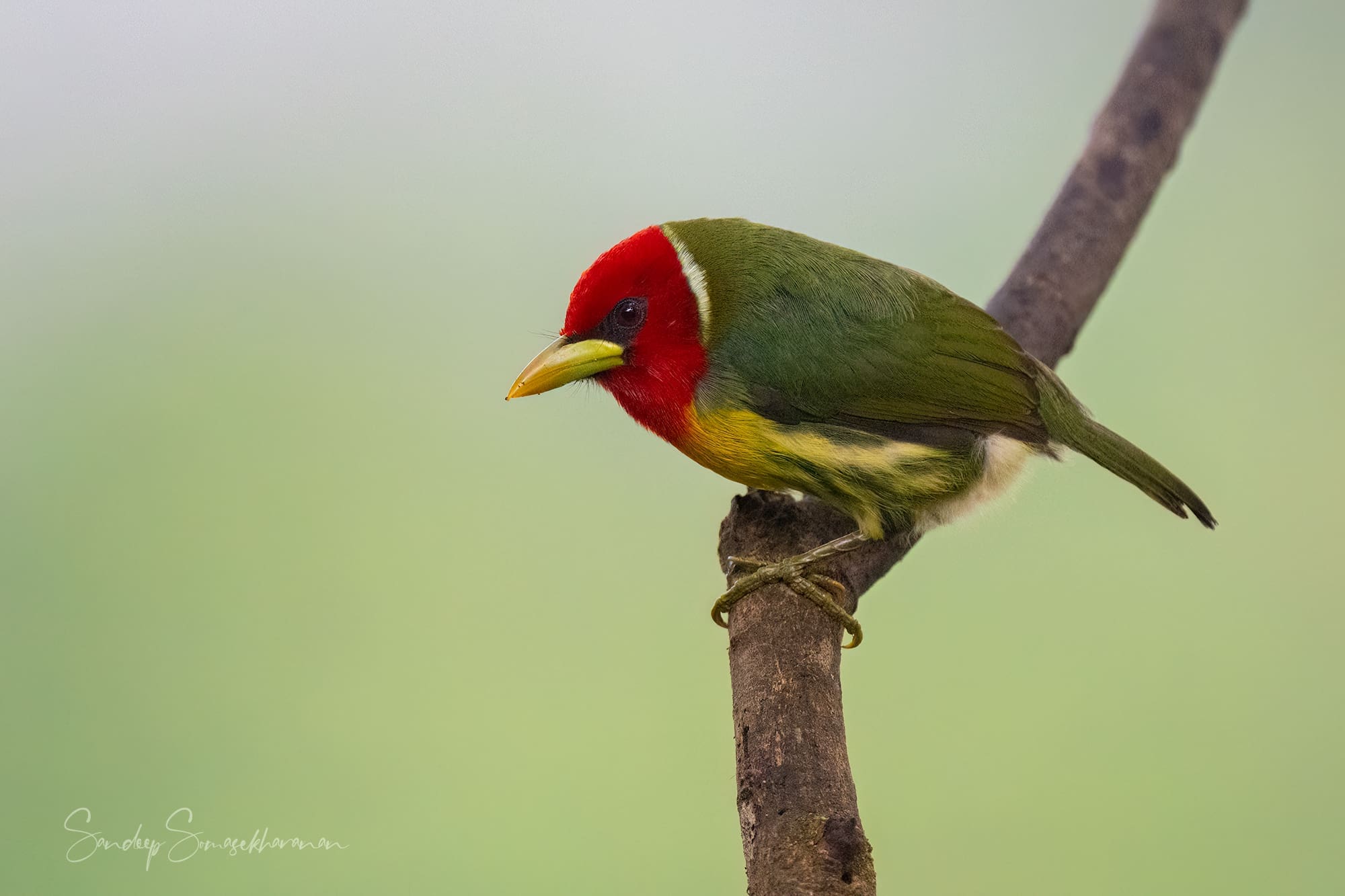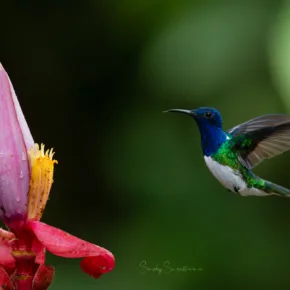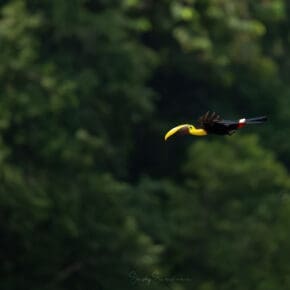Recap: On Day 2 in Costa Rica, we tramped through the squelchy mud of the rainforest floor in Guapiles to watch owls in the murky light, and reaped many other rewards for our perseverance.
I wake up groggy and sleep-deprived. I had been up late to copy images from my overflowing memory card to my hard drive. While doing that, I accidentally deleted the images from Cinchona on my memory card. Frantic and panicking, I stayed up until 2 AM using a recovery tool to wrest back every photo that I had lost due to my carelessness.
Orlando, as usual, is ready and waiting for us at the cafeteria. Breakfast is even more sumptuous today because we are not having an early start and the folks in the kitchen have been given enough time. There is fruit, egg, toast, and the Costa Rican staple, Gallo Pinto — which is rice and beans cooked together with some kind of salsa. It translates to “spotted rooster” referring to the contrast of the dark beans against the white rice. We soon find out that Gallo Pinto is served for all three meals.
After birding a bit on the premises, we pile into Orlando’s Toyota. Despite Cope scrubbing down our shoes, we had made a bit of a mess inside the van the day before. None of that was visible this morning as Orlando had cleaned out the mats in the car overnight. Pranav and I work on the bird checklist as Orlando drives us toward Boca Tapada, our next destination. Boca Tapada means ‘covered mouth’, and the drive is quiet and peaceful through cultivation and open country. We spot kids playing soccer along the way, tiny schools, and small villages. It is Christmas, but there are no signs of celebration here.
There’s a bit of confusion as we get to Boca Tapada. We are told that the rooms at the Boca Tapada Lodge will be ready around noon, and we are to first go to Mirador El Pizote and meet Edward, our guide for the next couple of days. However, Edward suggests we go and check in first, so we head back to the lodge. Past the entrance to the lodge is a steep climb that Orlando negotiates with consummate ease. We drive up to a cafeteria and alight to stretch our legs. There seem to be no cottages nearby and we wonder if we are at the right place. The cafeteria is at the top of a hill and we can see the landscape fall away in front of us towards a flowing river that we later know is the San Carlos River.
I notice a ghostly white bird that looks like a tanager flying towards us. Pranav and I pore over Merlin and the book to figure out what it is. We are stumped, and so is Merlin. After returning to the US, via a Facebook group, we identify it as a Snowy Cotinga (Carpodectes nitidus).
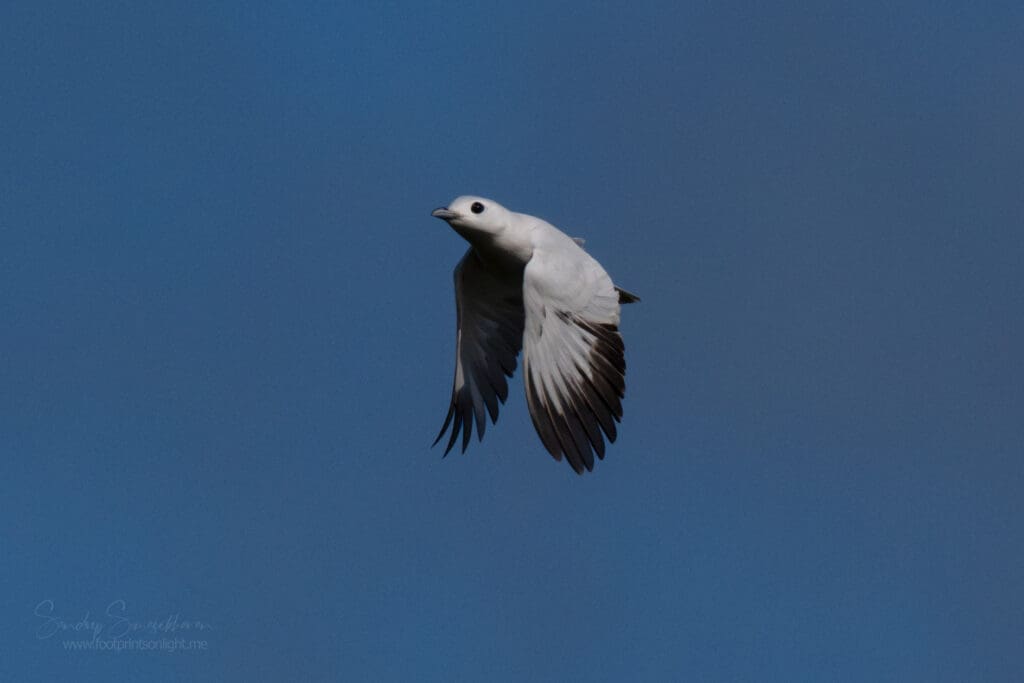
We walk around the property and use the restroom. There is a Christmas tree with a cat lounging under it. An extremely pleasant girl of around 19 or 20 greets us and introduces herself as Ericka. She helps us with the check-in process. She speaks some English and gets by with Google Translate when weighty topics need to be discussed. While picking our dinner options we notice a plantain feeder erected a few feet away. This one is a tray that is pulled up a tree with a chain, on which are laid skinned plantains. There are the birds that we had seen the day before at Sarapiqui and Guapiles – the Red-legged Honeycreeper, a pair of Black-cheeked Woodpeckers, Scarlet-rumped, Palm, and Blue-grey Tanagers, and another Buff-throated Saltator (Saltator maximus).
Then arrives a bird that has us scrambling for a good look — or a shot. It seems to wear the colours of the national flag of Ukraine — vibrant blue on the upper side and stunning yellow on the underside. This Yellow-throated Euphonia (Euphonia hirundinacea) seems pretty shy about staying out in the open for long. It flies in, pecks at the plantains, and disappears.
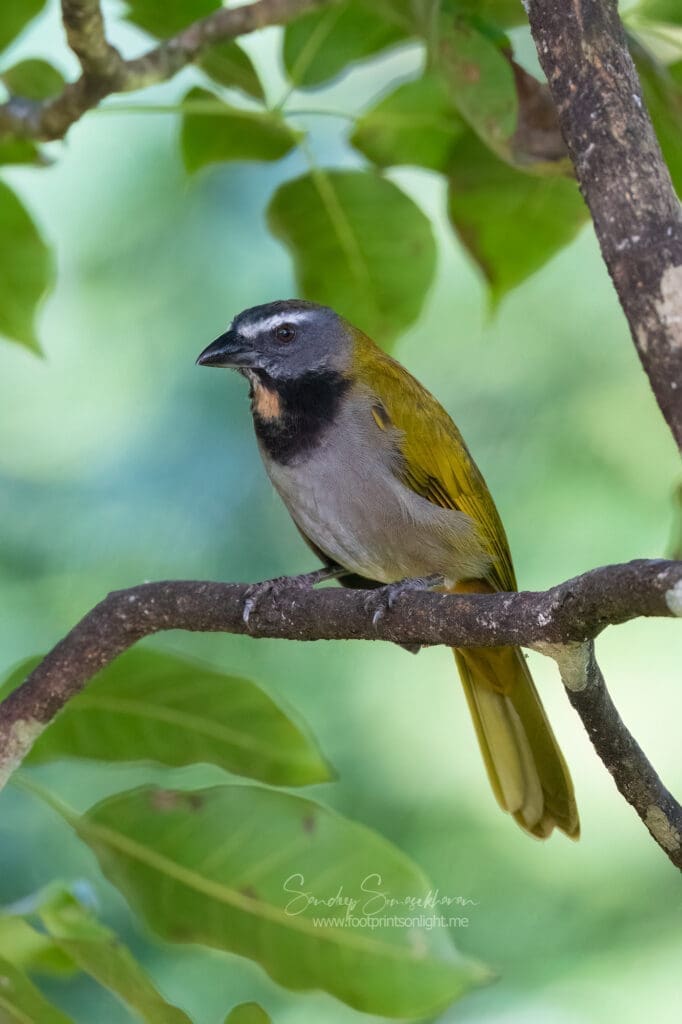
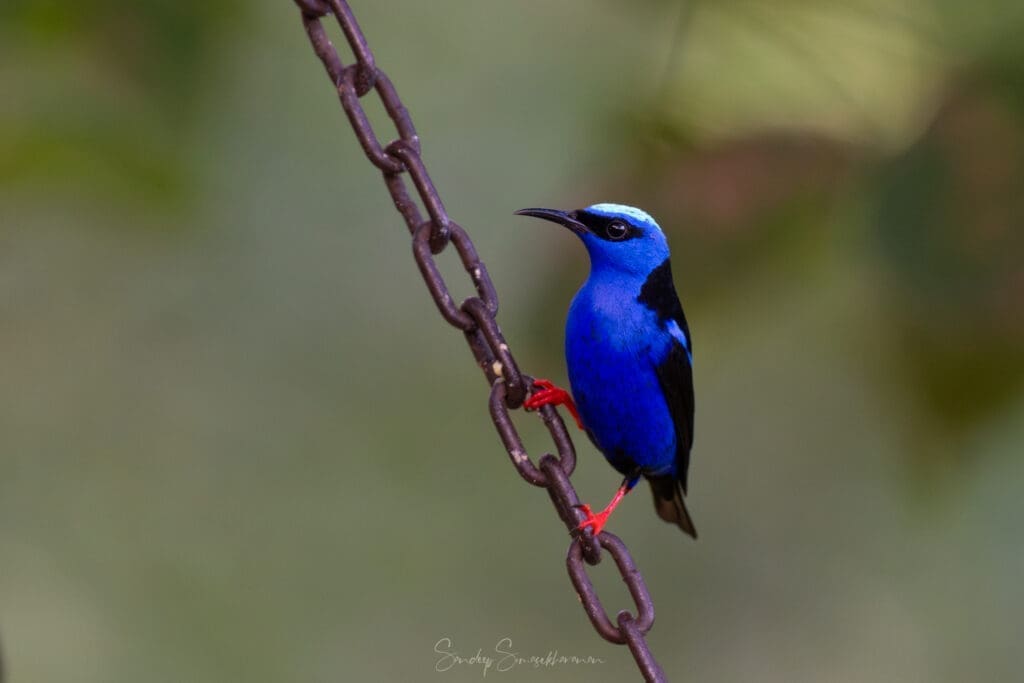
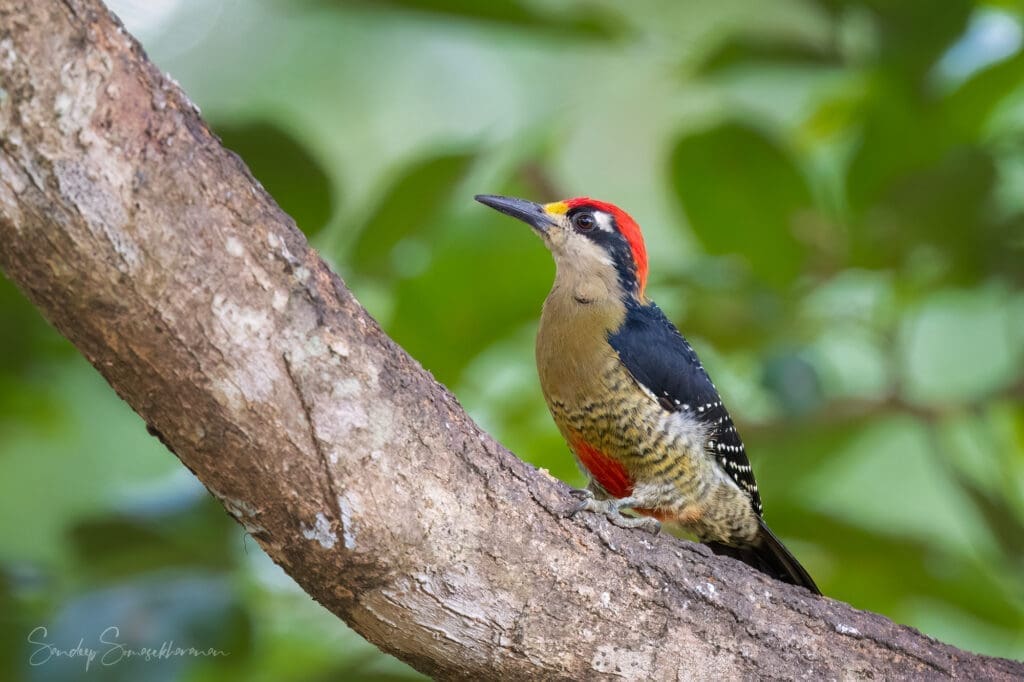
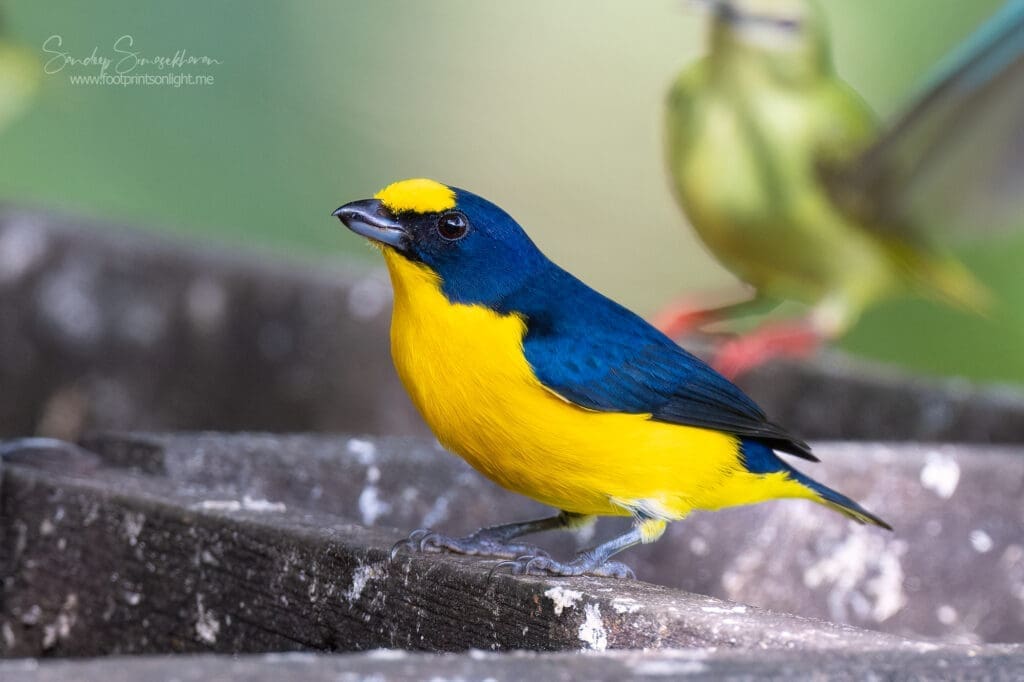
Ericka guides us to our rooms, which are located in a steep drop about a 10-minute walk from the cafeteria. Since we have our luggage, Orlando drives us down to the cottages, which are located along the river. Behind my cottage is an enormous tree, and beyond that flows the massive San Carlos River.
I can hear the loud bubbling call of a Montezuma Oropendola somewhere the canopy. The cottages are way simpler and minimalistic compared to La Quinta. There is a beautiful patio overlooking the river, furnished with a pair of benches, a table, and a hammock, and it hits me hard in the gut that I wouldn’t be finding any time to lounge there. Maybe, on another trip without a birding agenda, I think. The shower is in the open and is the first of the kind I have ever seen, except in ads and travel videos. Outside, there is a huge tree with pink fruits which I recognize as Java Apples, something that was a bit of a treat when I was growing up. We shed our luggage and get back in the van and Orlando drives us to El Pizote.
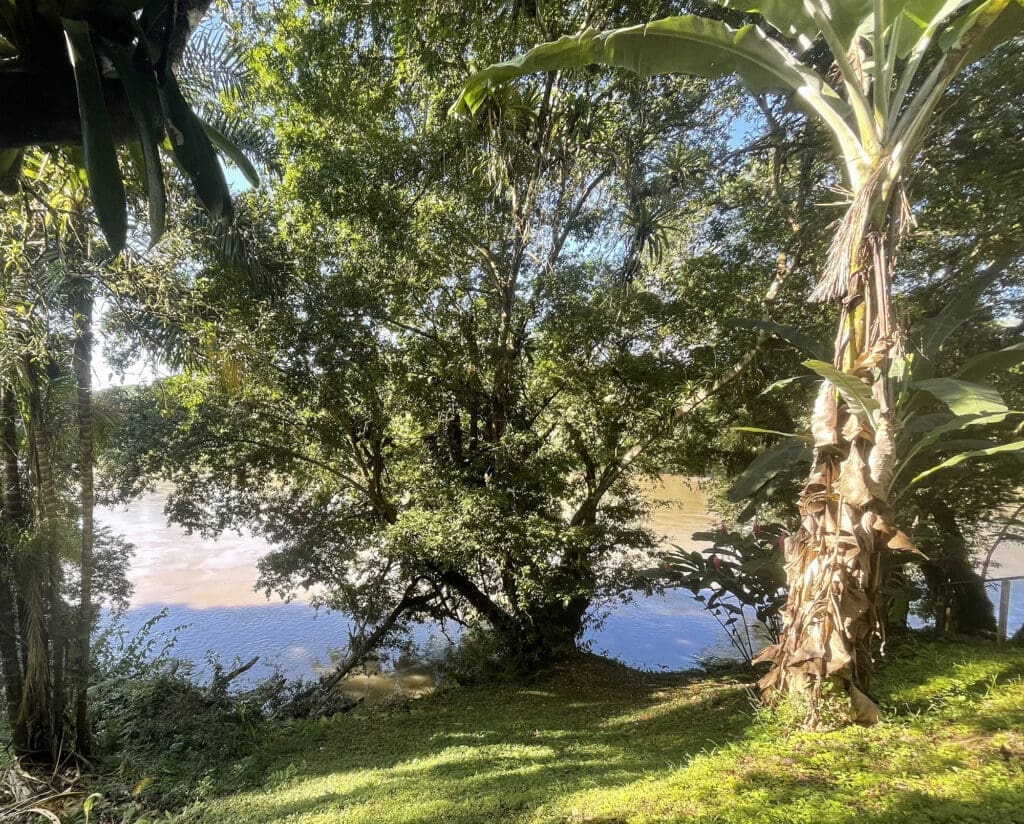
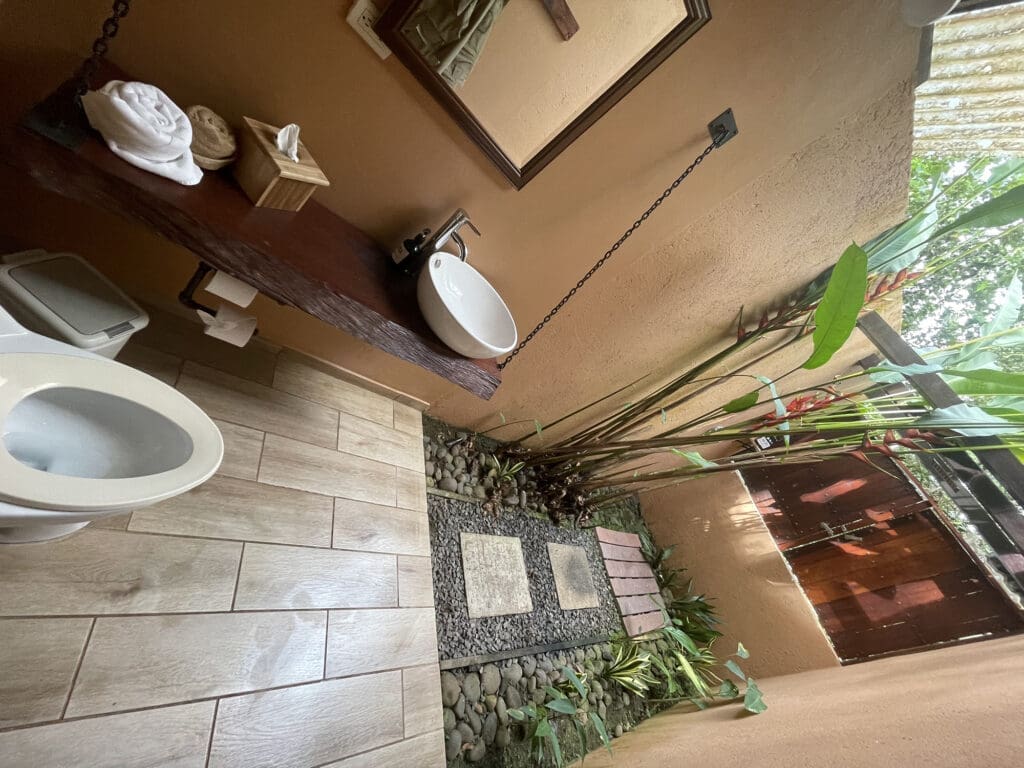
We are greeted by a slim man with glasses who introduces himself as Sergio. He speaks decent English and takes us to the deck, where there are two feeders: a smaller one for the little birds closer to the deck, and another further away for the larger ones.
As we sit there, we are joined by Edward, who runs the business. He is wearing a tee shirt with the name of his company and a photo of a Gartered Trogon (Trogon caligatus). We have the first sighting of the Shining Honeycreeper (Cyanerpes lucidus), which looks almost like the Red-legged Honeycreeper, but with yellow legs, lacking the smattering of the snow-cap on the head, and without the yellow on the underwing. Another new bird turns up, which we recognize as an oriole from the shape of the body. “Black-Cowled Oriole (Icterus prosthemelas),” says Edward.
We remain on the deck photographing birds for a few minutes when Edward suggests that we head out to look for King Vultures (Sarcoramphus papa).
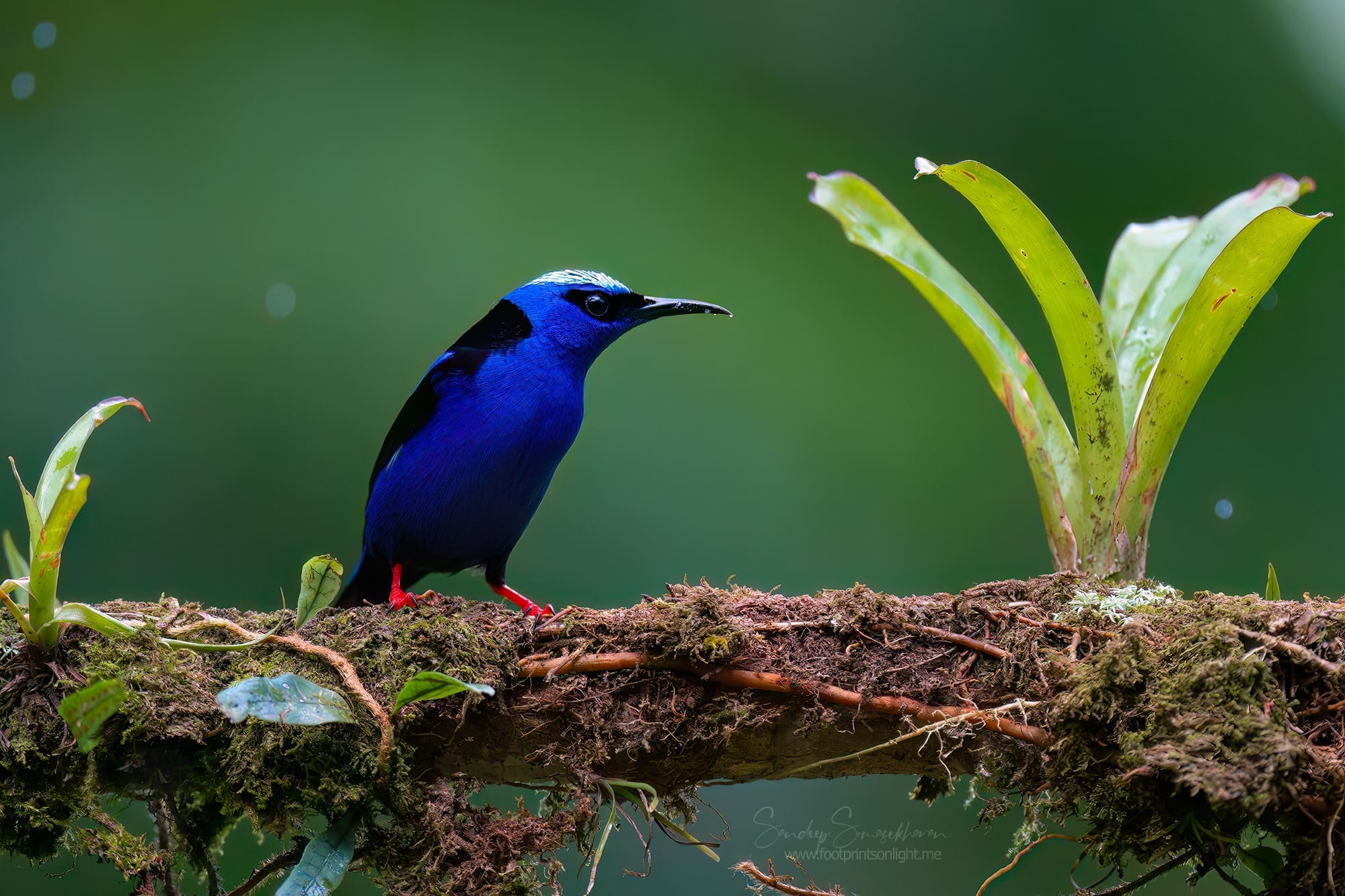
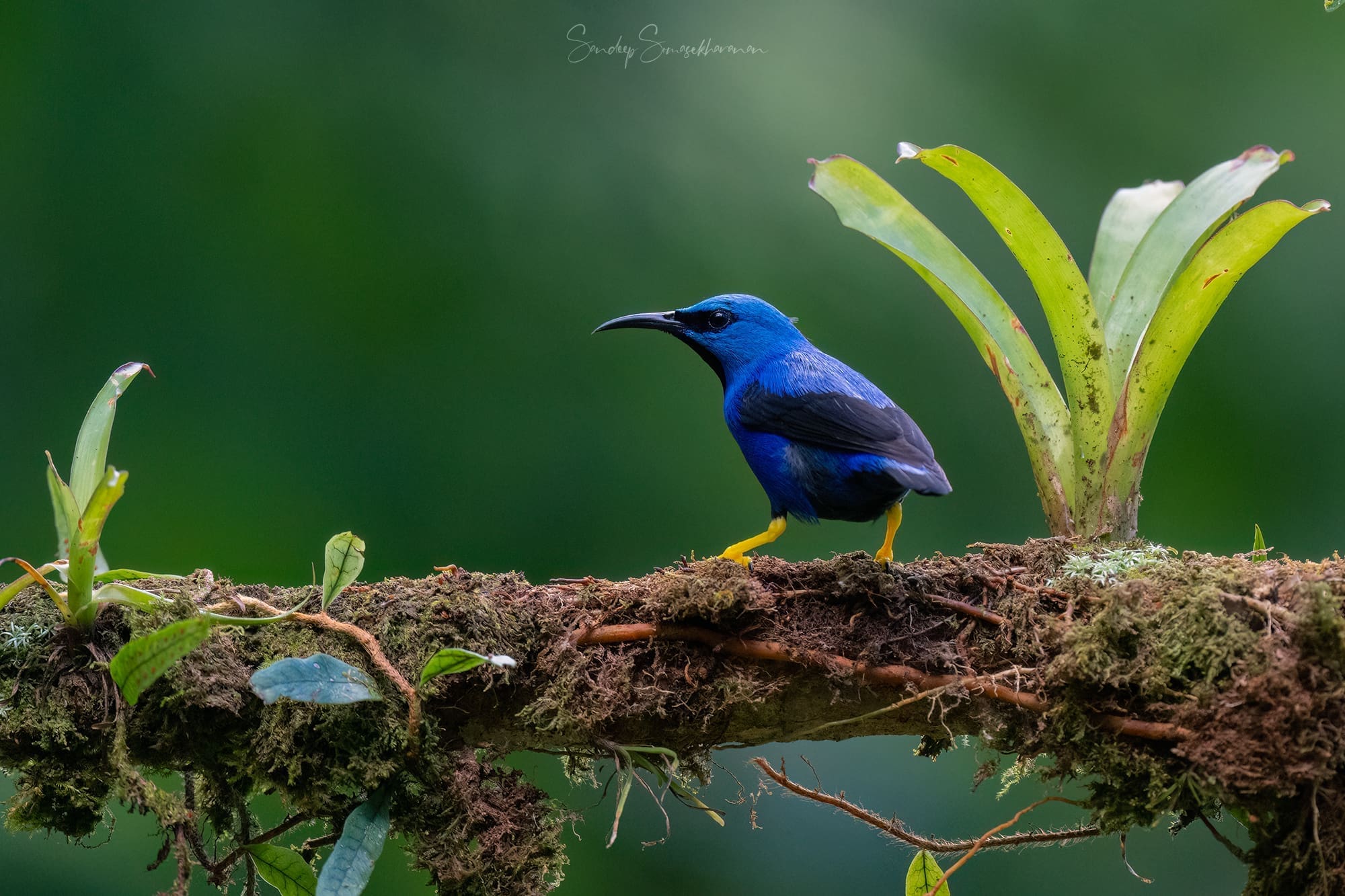
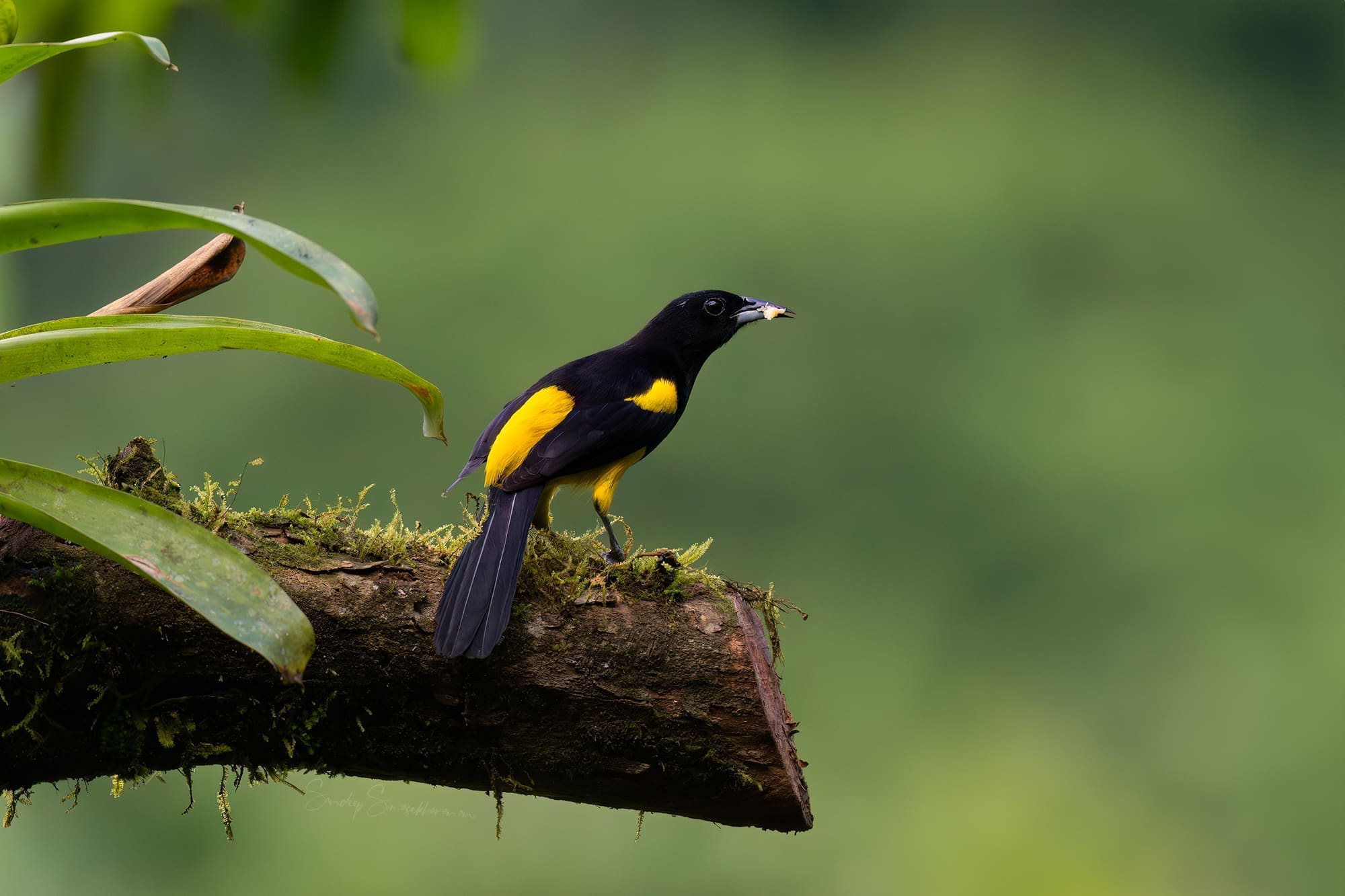
We cross the road in front of El Pizote to climb the hill right behind us. The climb is steep, but thankfully I have been in good shape recently, so I get to the top just out of breath and not wheezing for air like I did after my twenty minutes in the Himalaya. Edward asks us to be quiet, as the vultures are very sensitive to loud noises. A hide has been built here: a shed with a few windows for camera lenses to peek out of. Even those windows are covered with flaps of canvas, which tells us how shy these birds are.
Edward and Sergio lift the flaps and we see a committee of vultures (yes, that’s the word for a group of vultures, as are “wake” and “kettle”; flock is also used, but that isn’t as much fun, is it?). But these are Black Vultures (Coragyps atratus), the kind we see ‘mourning’ over every roadkill in the US. Then, right beyond them, we see a flash of white.
One look and you can tell why these are called King Vultures. The upper body is a beautiful ivory color, and the flight feathers are black. Right below the neck is a tuft of feathers that gives the bird the appearance of wearing a scarf. The neck and the beak are orange-red, and there is an orange wattle just above the beak. The eye is startlingly white, with a black iris and an orange eye-ring. We ooh and aah, as the birds peck at something in a ditch just outside the shack. It appears to be a feeder set up for the vultures, and Edward confirms that they serve the king vultures pork occasionally, so they frequent this location. There is also a juvenile, which looks pretty much like the black vulture except for the thicker bill and a less furrowed face. There is also a subadult bird that has a completely black back, but a face like the adults.
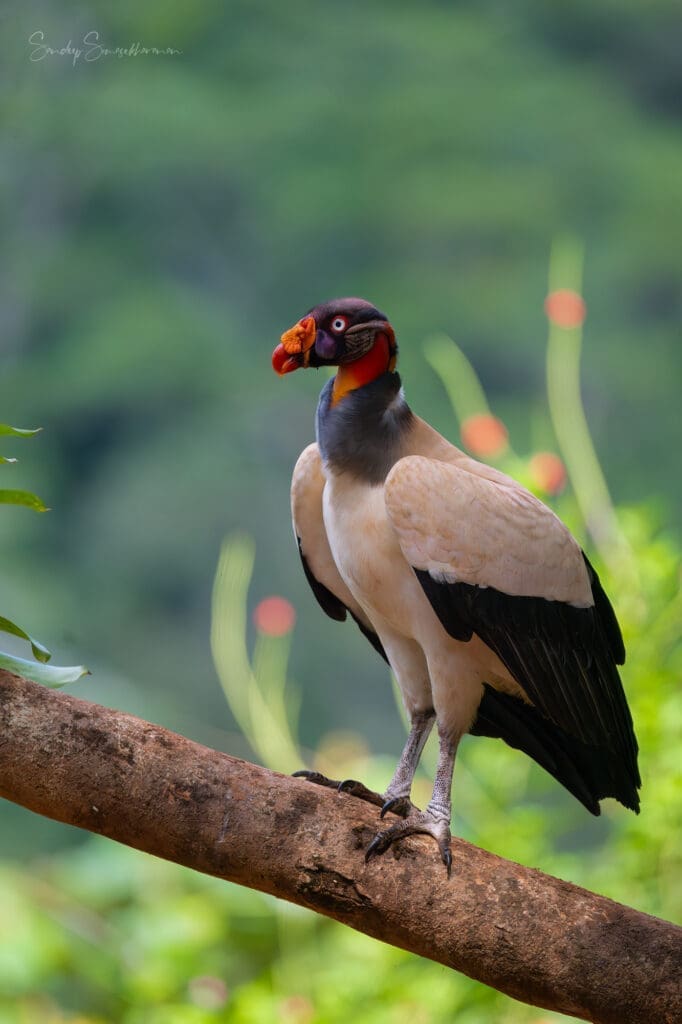
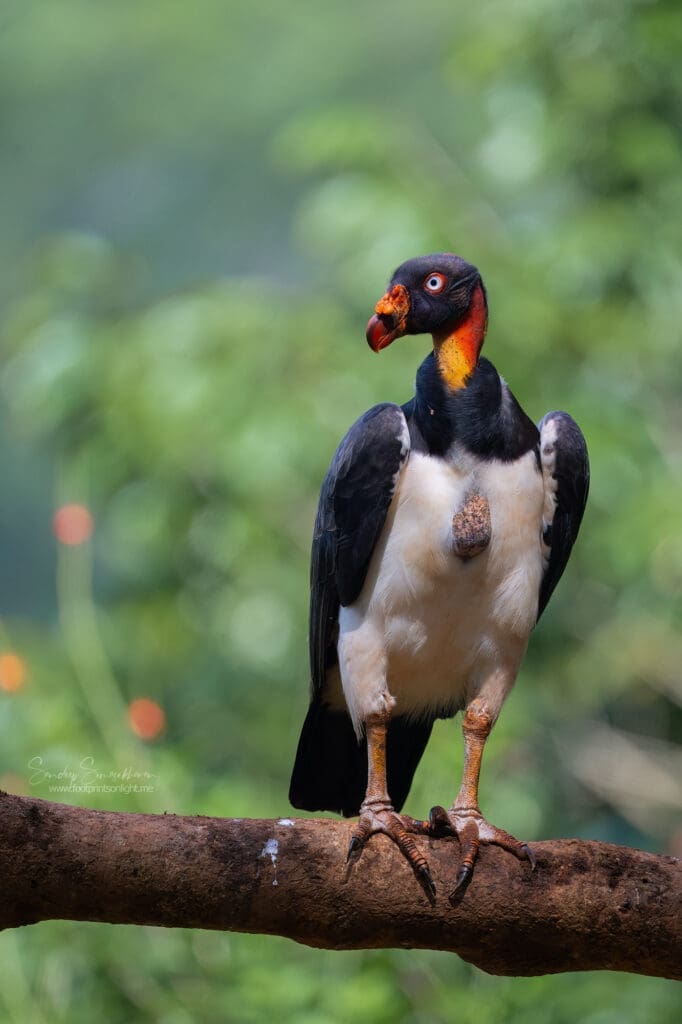
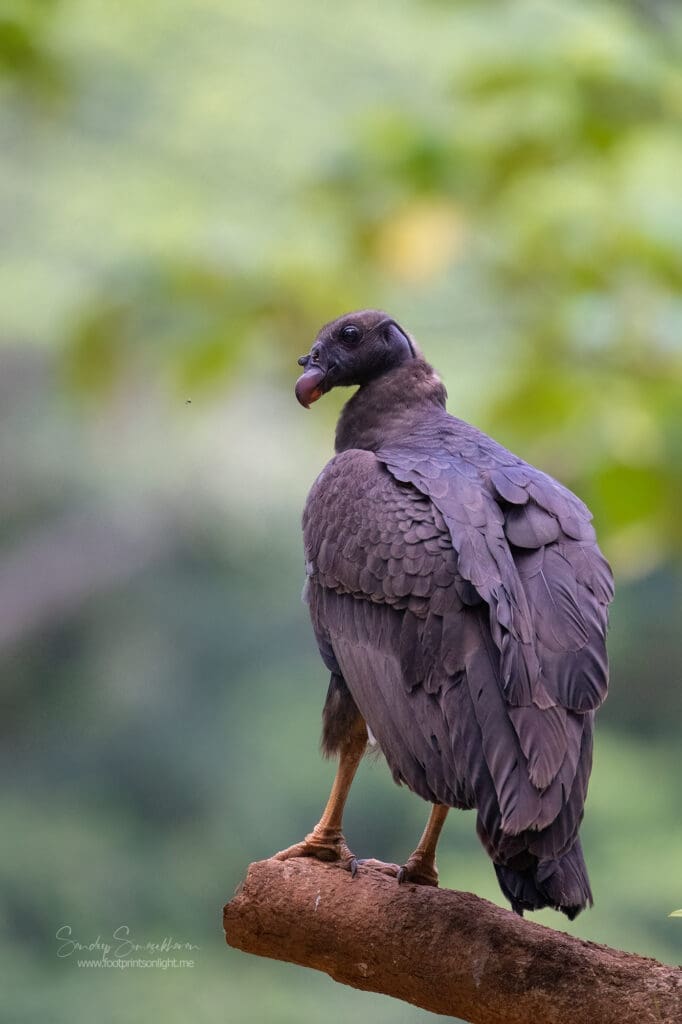
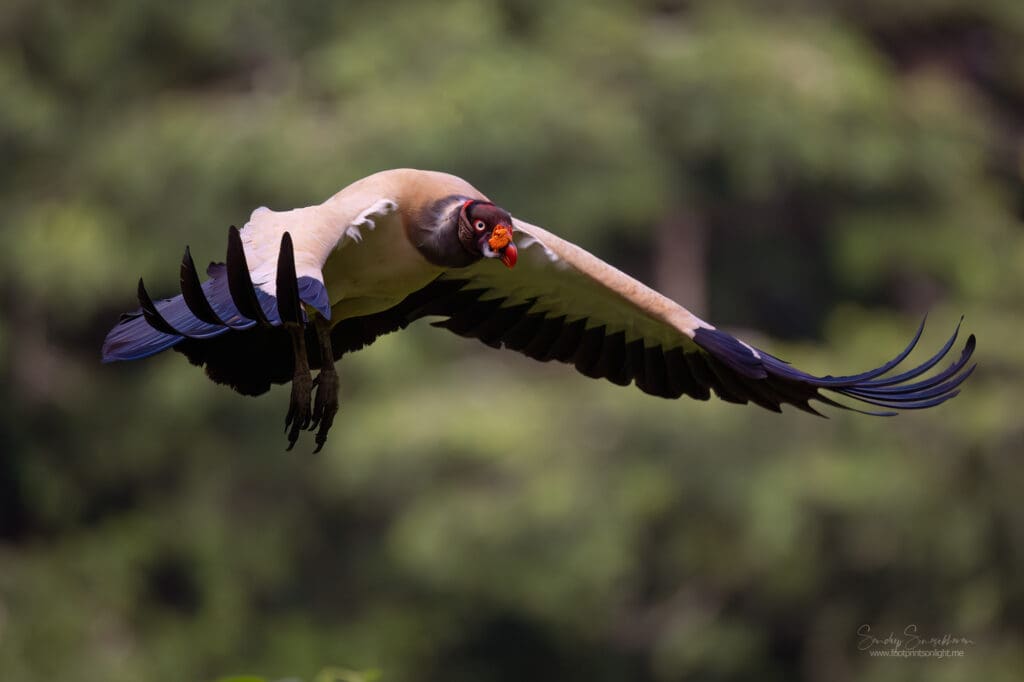
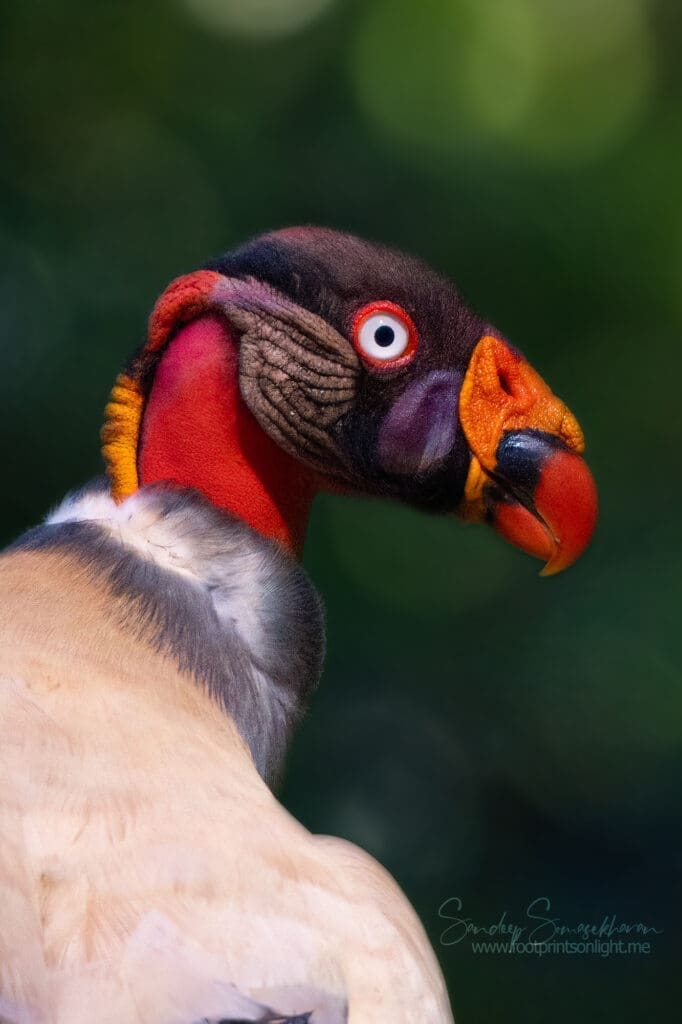
After some quality time with the vultures, we head down. There are some interesting sights as we climb down, such as odd-looking creepers, ants carrying leaves, and pretty fungi. The climb down is a little more taxing on the knees, but we make it down without incident.
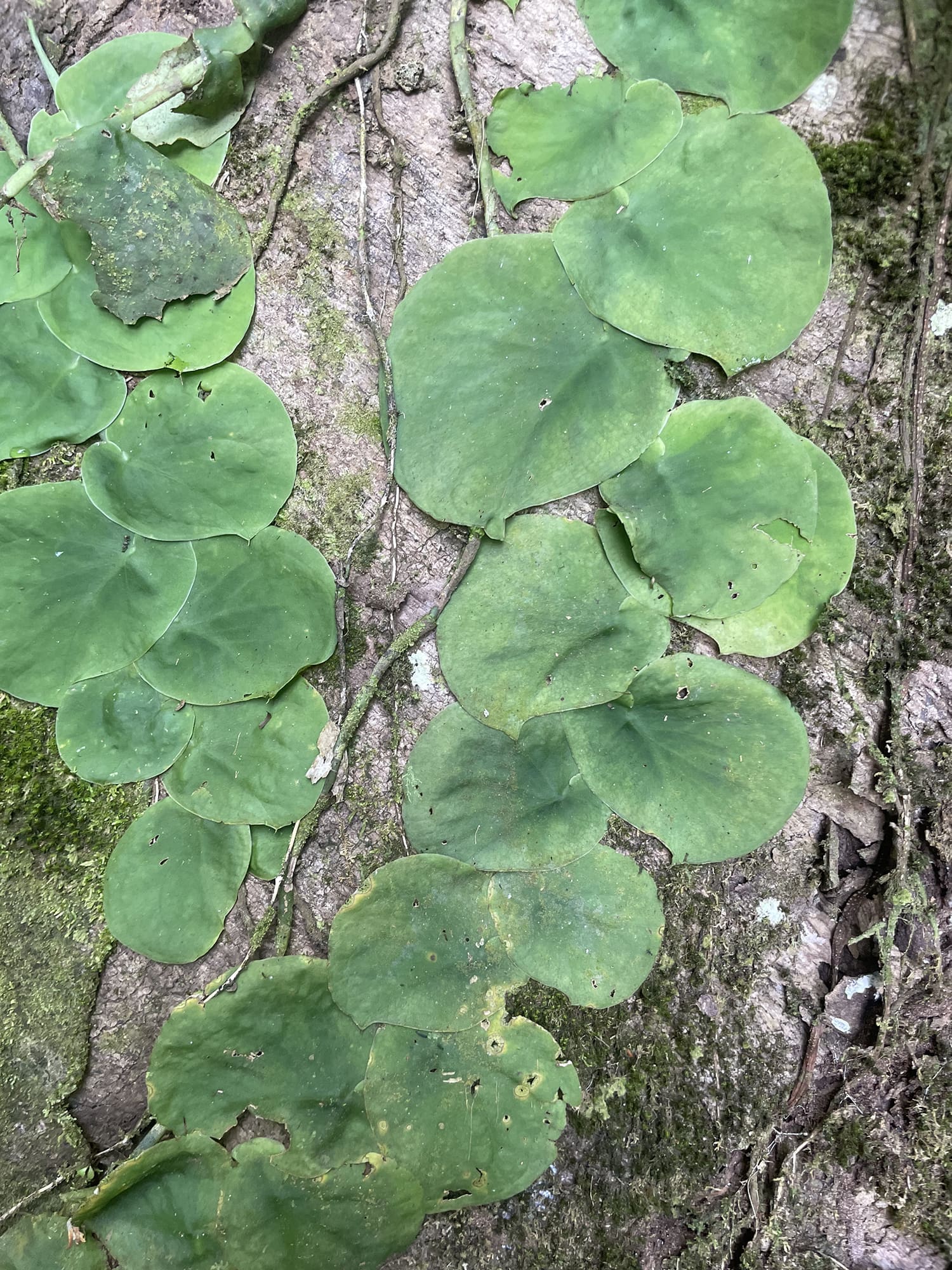
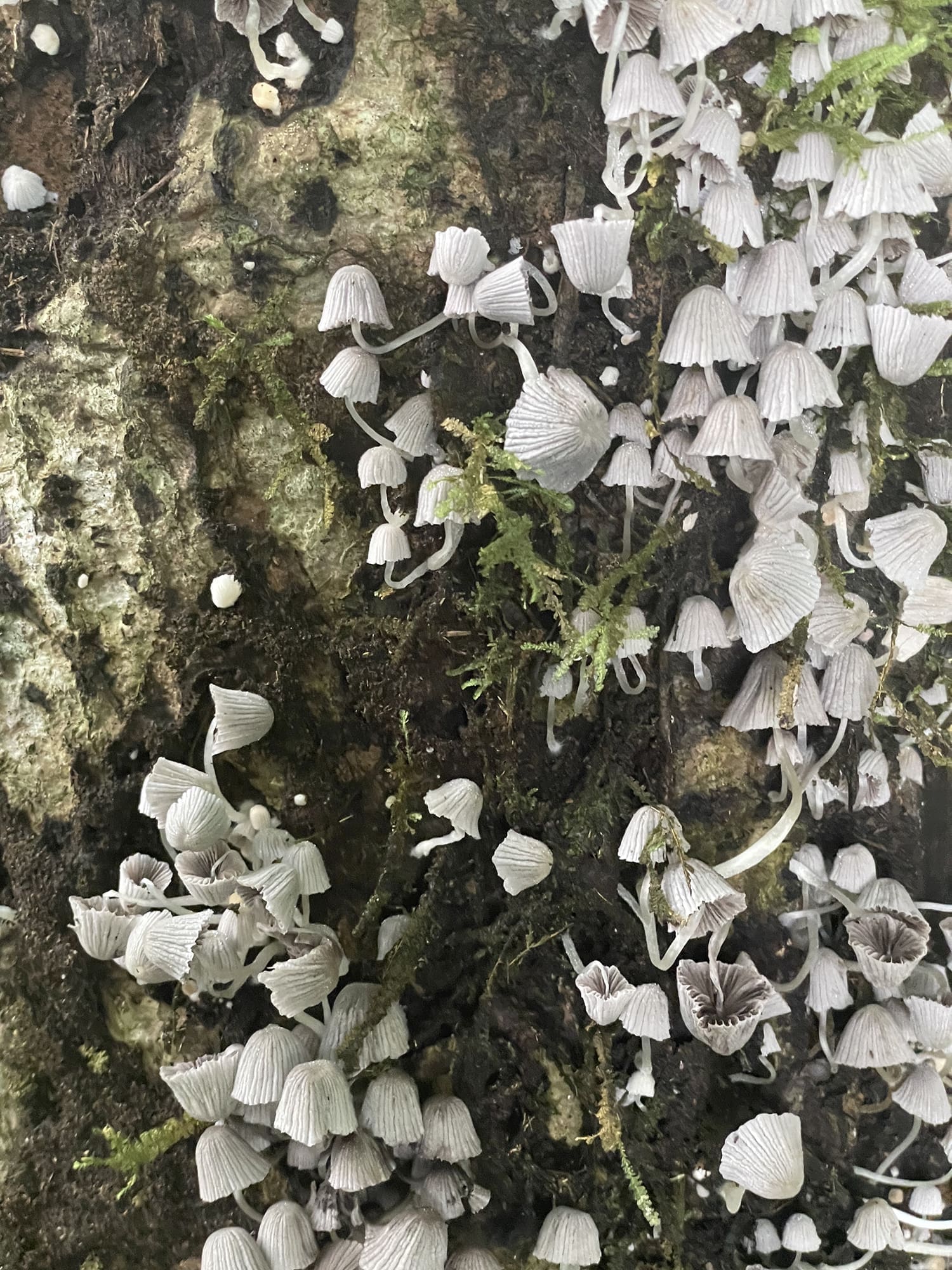
Back on the deck, we find Collared Aracaris (Pteroglossus torquatus), Baltimore Orioles (Icterus galbula), Black-cheeked Woodpeckers (Melanerpes pucherani), Yellow-throated and Olive-backed Euphonias (Euphonia gouldi) that turn up at the feeders. A Keel-billed Toucan (Ramphastos sulfuratus) also appears but doesn’t linger, to our dismay. Then, a new guest arrives and fills us with excitement. This is a shy Squirrel Cuckoo (Piaya cayana), and it gives us a glimpse from between the leaves. It never comes to the feeder, so we never get to see its full body. We also get a glimpse of the Golden-hooded Tanager, of which we had had brief sightings at La Quinta.
We point to Edward’s t-shirt and ask him if we can find the trogon that is printed on it. He spends some time speaking in Spanish on his phone and holds out the Google translator. “The trogon is usually uncommon in these parts during the rest of the year. They find plenty of berries and food in the forest during this time of the year. April is when they turn up at the property.” We are a tad disappointed, but accept this as birding reality. It is irrational to expect to see all the target species on any trip.
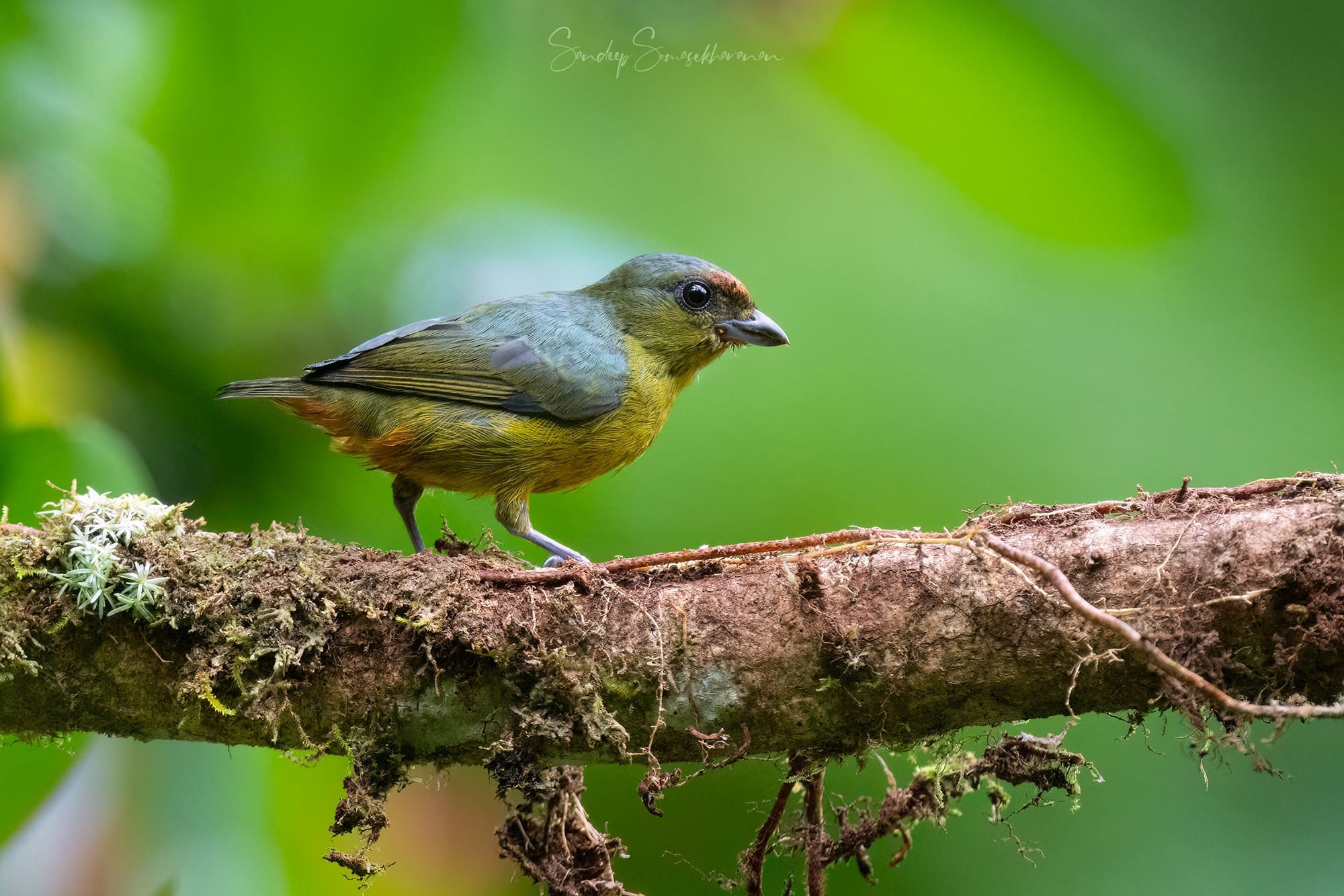
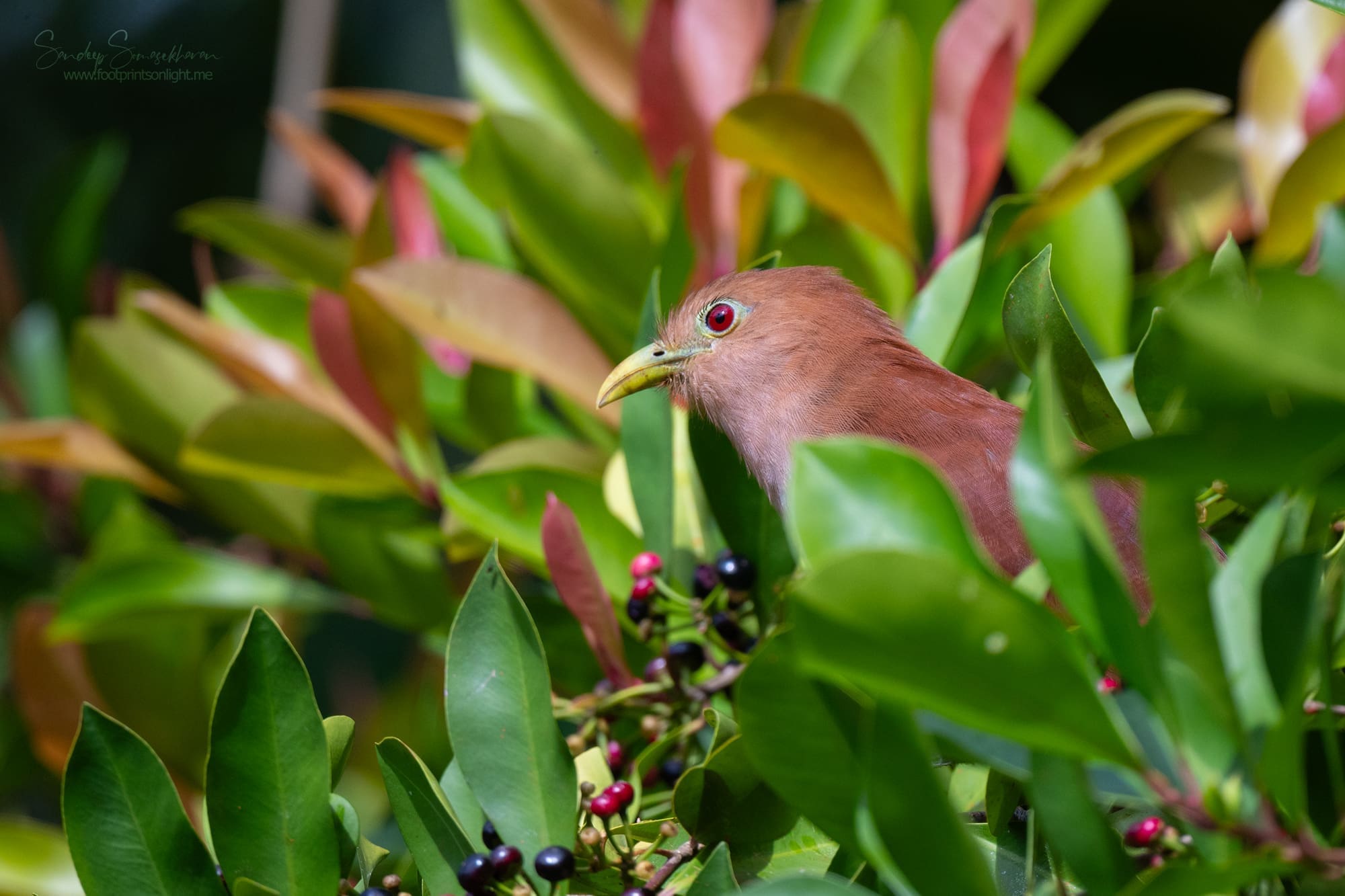
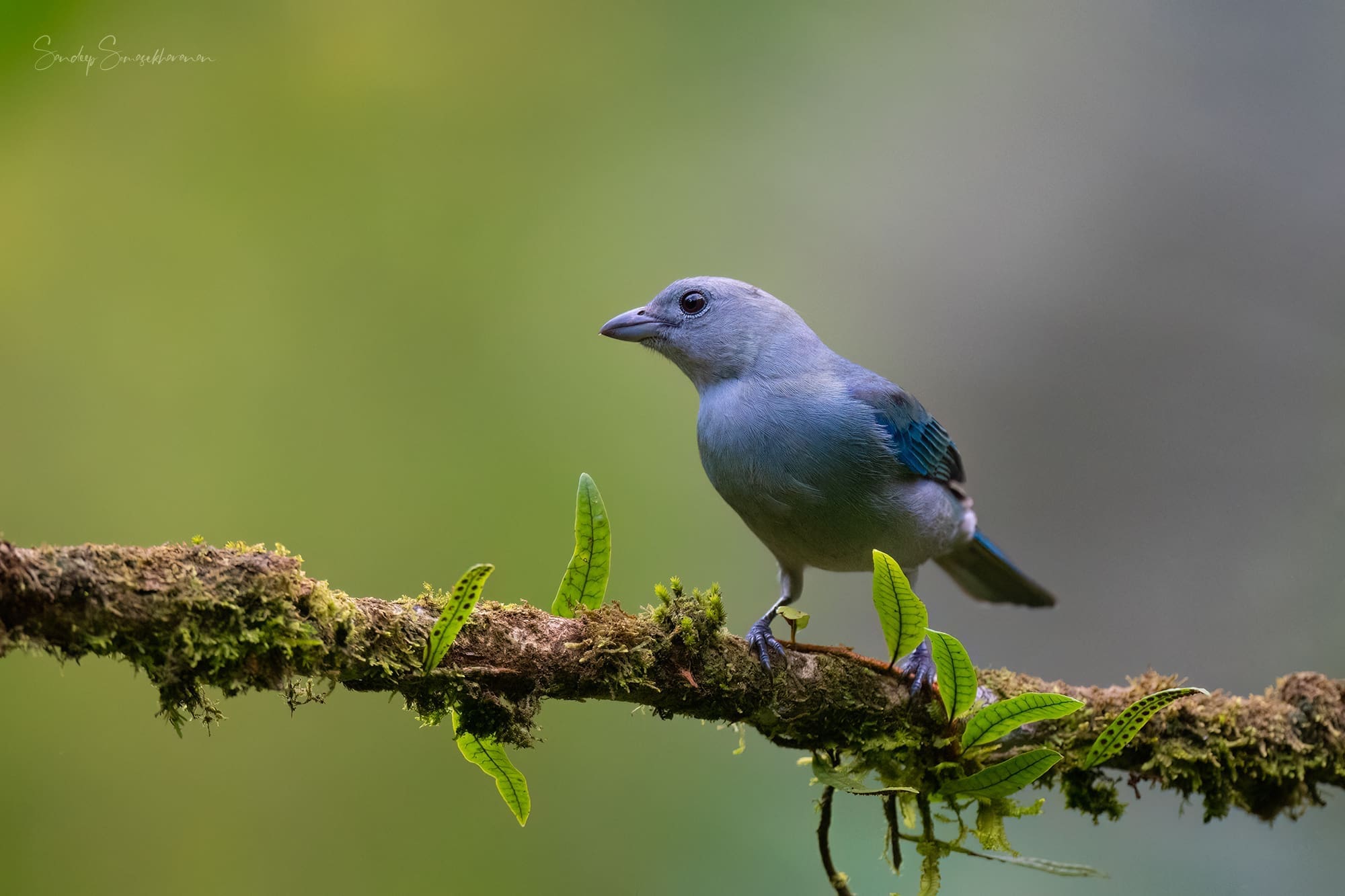
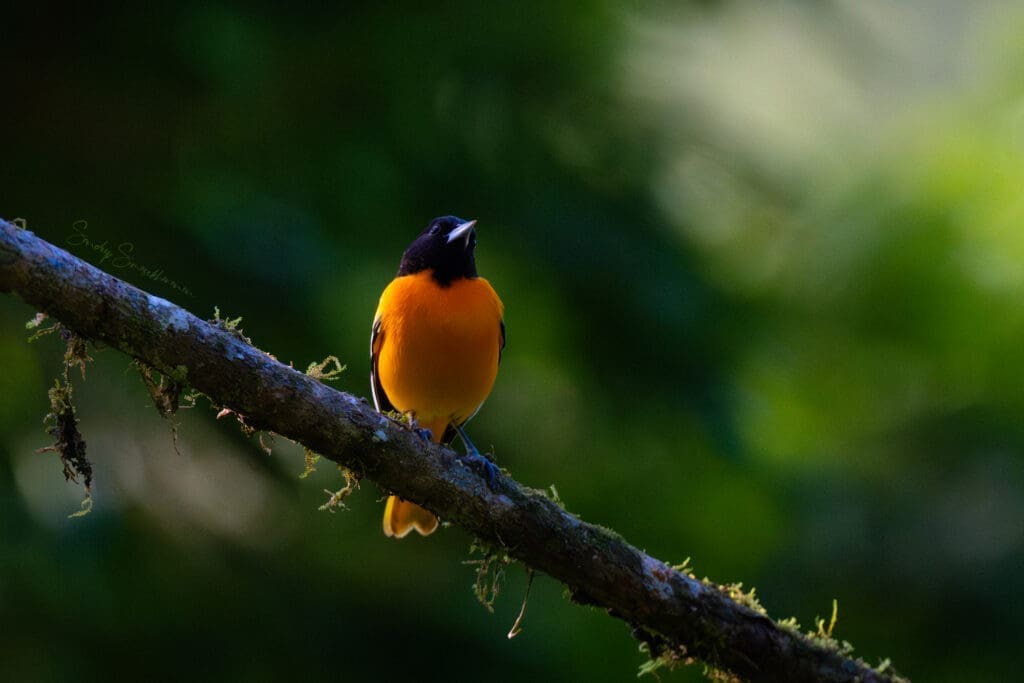
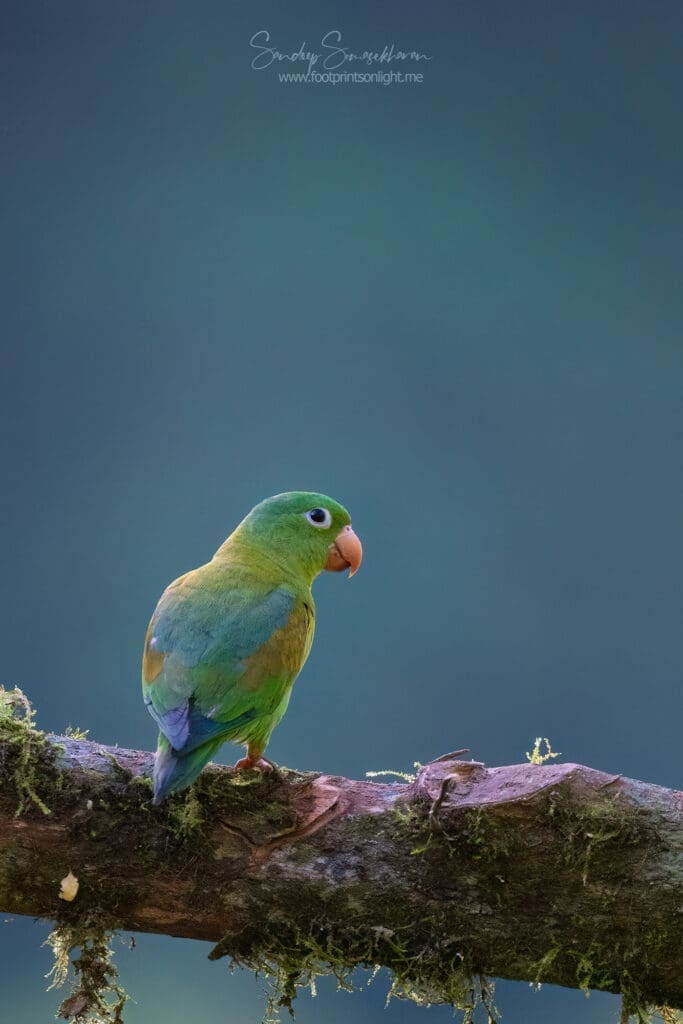
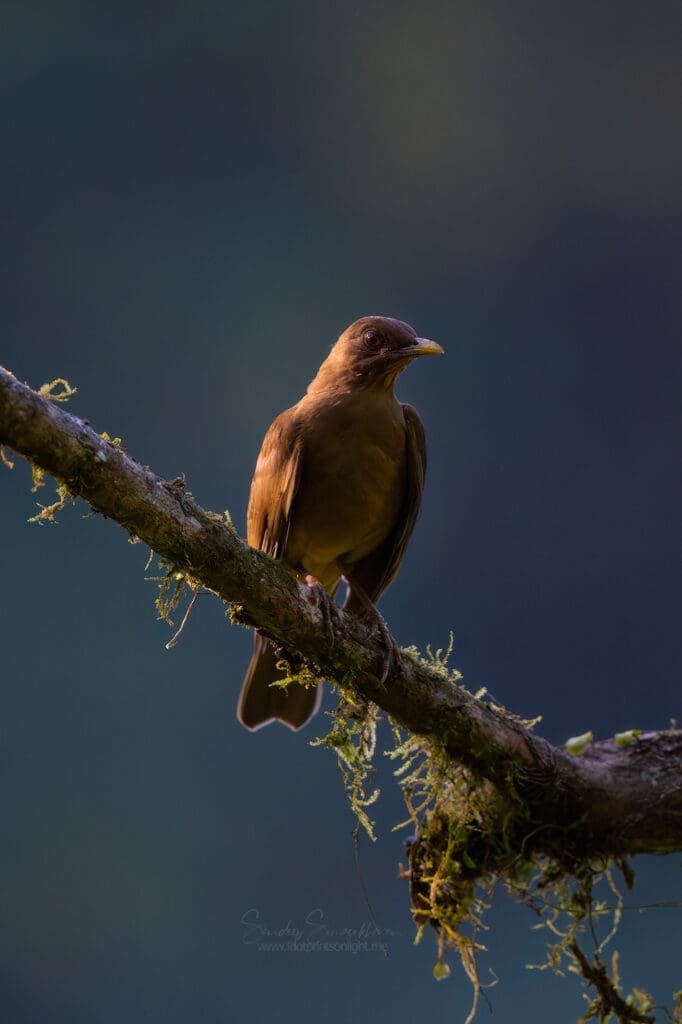
Around 1 pm, Edward lets us know that lunch is ready, and we follow him home, which is a hundred yards downhill from the feeder. They serve home-cooked meals at $10 per person, and they are worth every penny. There is passion fruit juice, which is refreshing beyond words, a salad made of lettuce and tomato with lime juice seasoning that I could happily sustain myself on for the rest of my life; Gallo Pinto, chicken, and fried plantain.
We are served by a young girl of around 10, and Edward introduces her as his daughter. We stuff ourselves till we can barely stand, but there is a Scaly-breasted Hummingbird (Phaeochroa cuvierii) parking itself on a bush nearby, which begs us to get back on our feet. A few yards away, a mammal appears, with a black body, a long tail, and a snooty face. Edward tells us that this is a Coati (Nasua narica), a relative of raccoons. Unperturbed by our presence, it ambles around for a bit before disappearing. The feeder is now almost empty and Edward suggests we return to the resort and rest for a bit. We happily comply and troop into Orlando’s van.
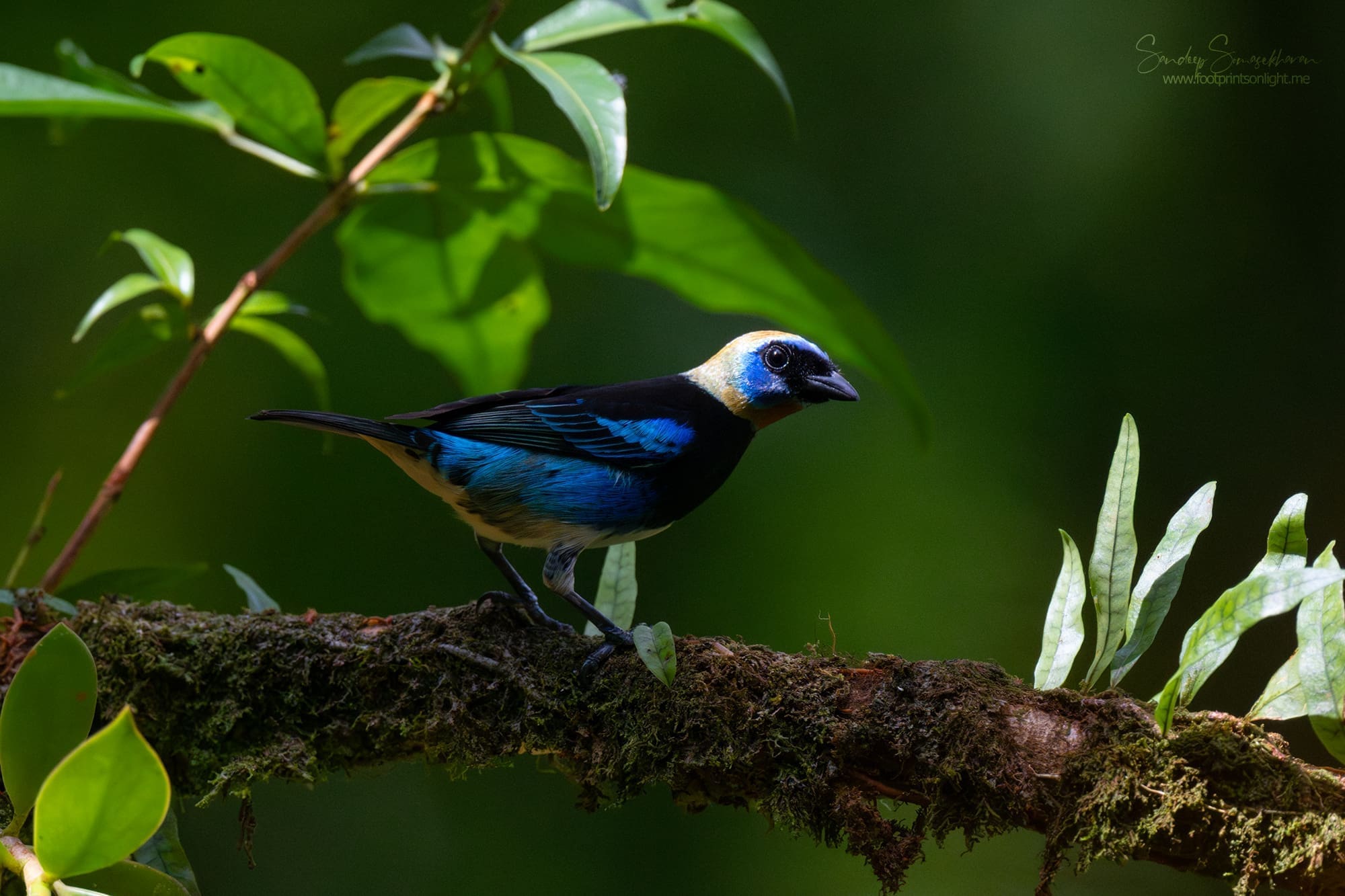
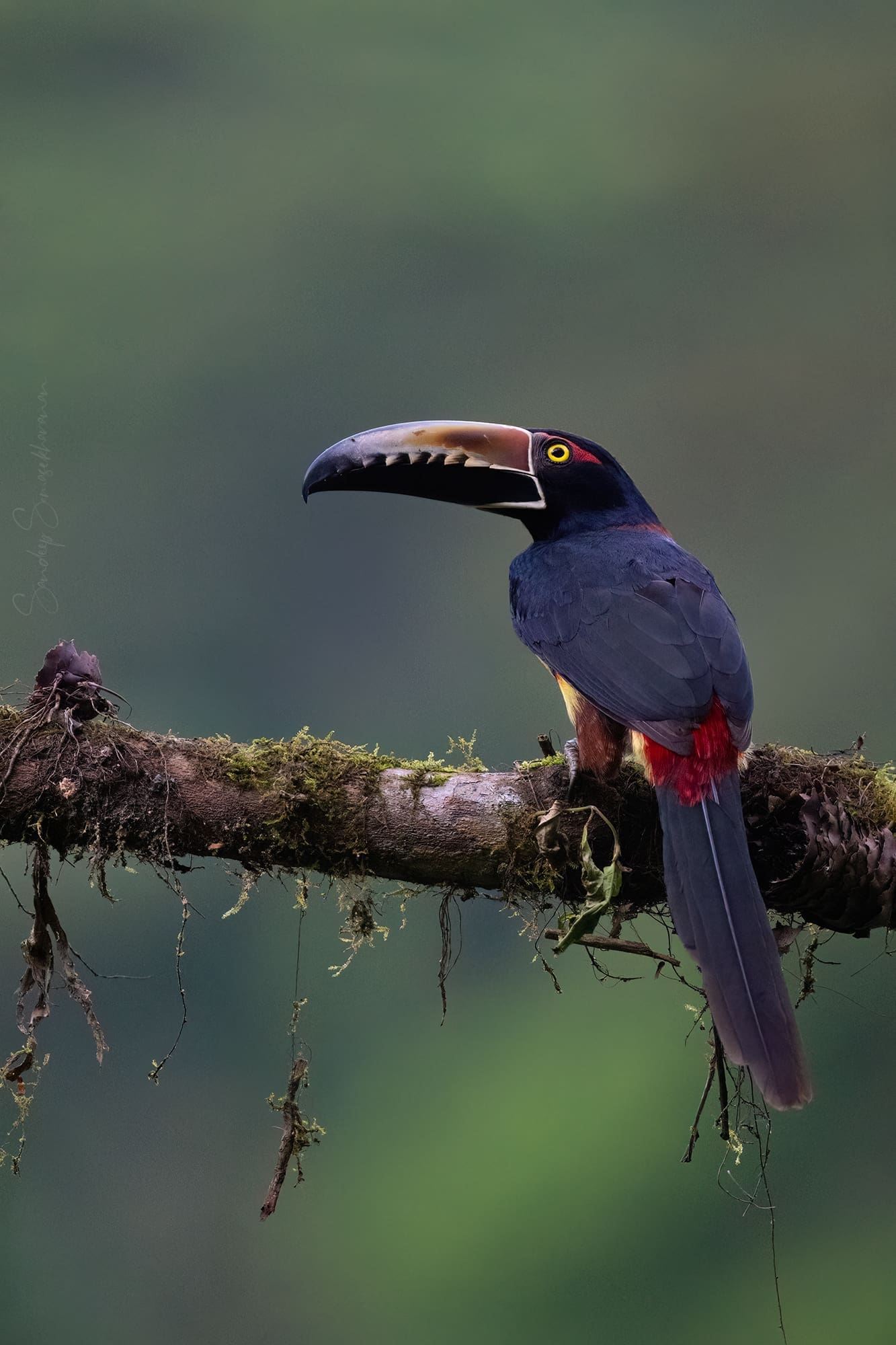
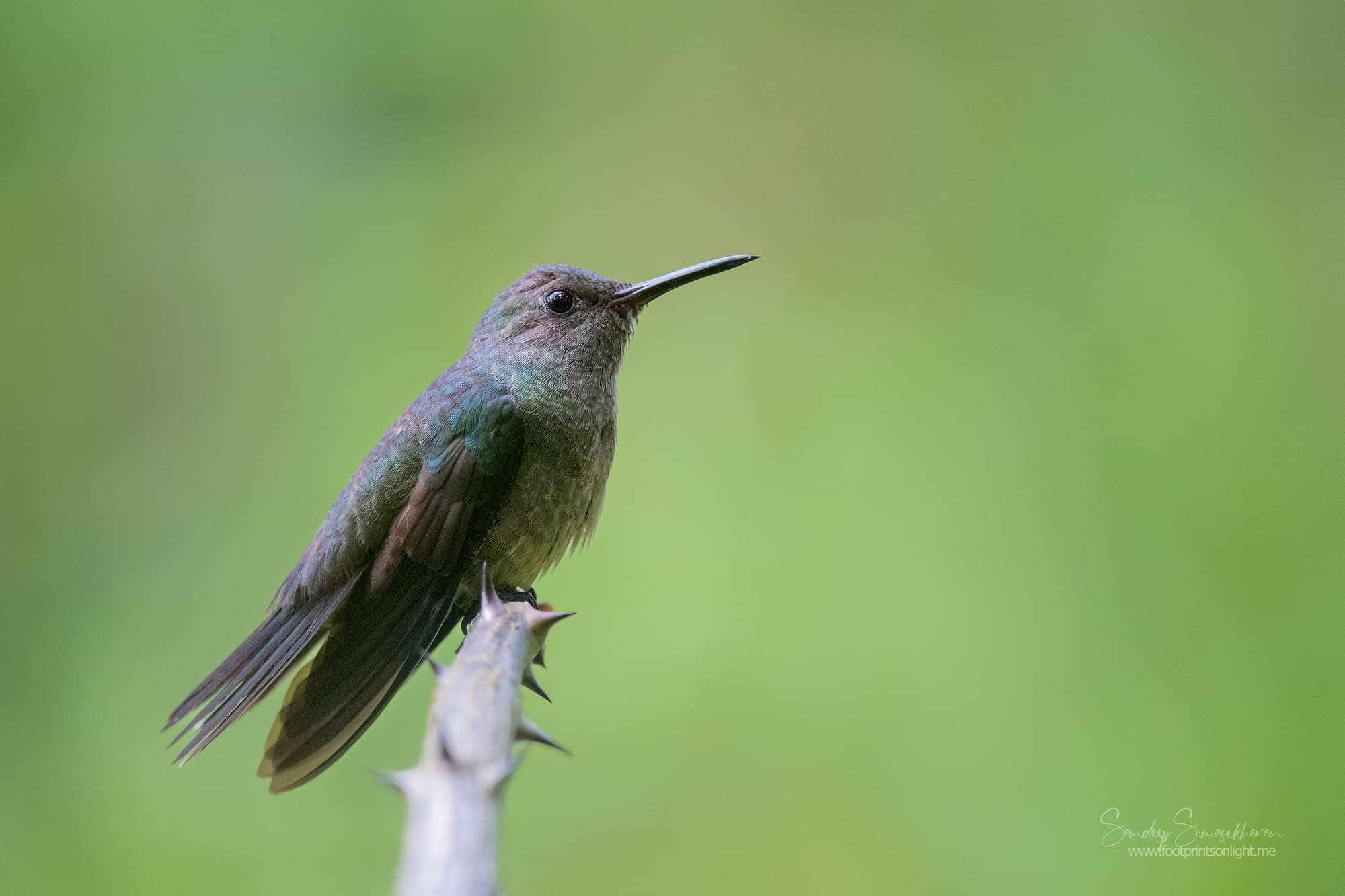
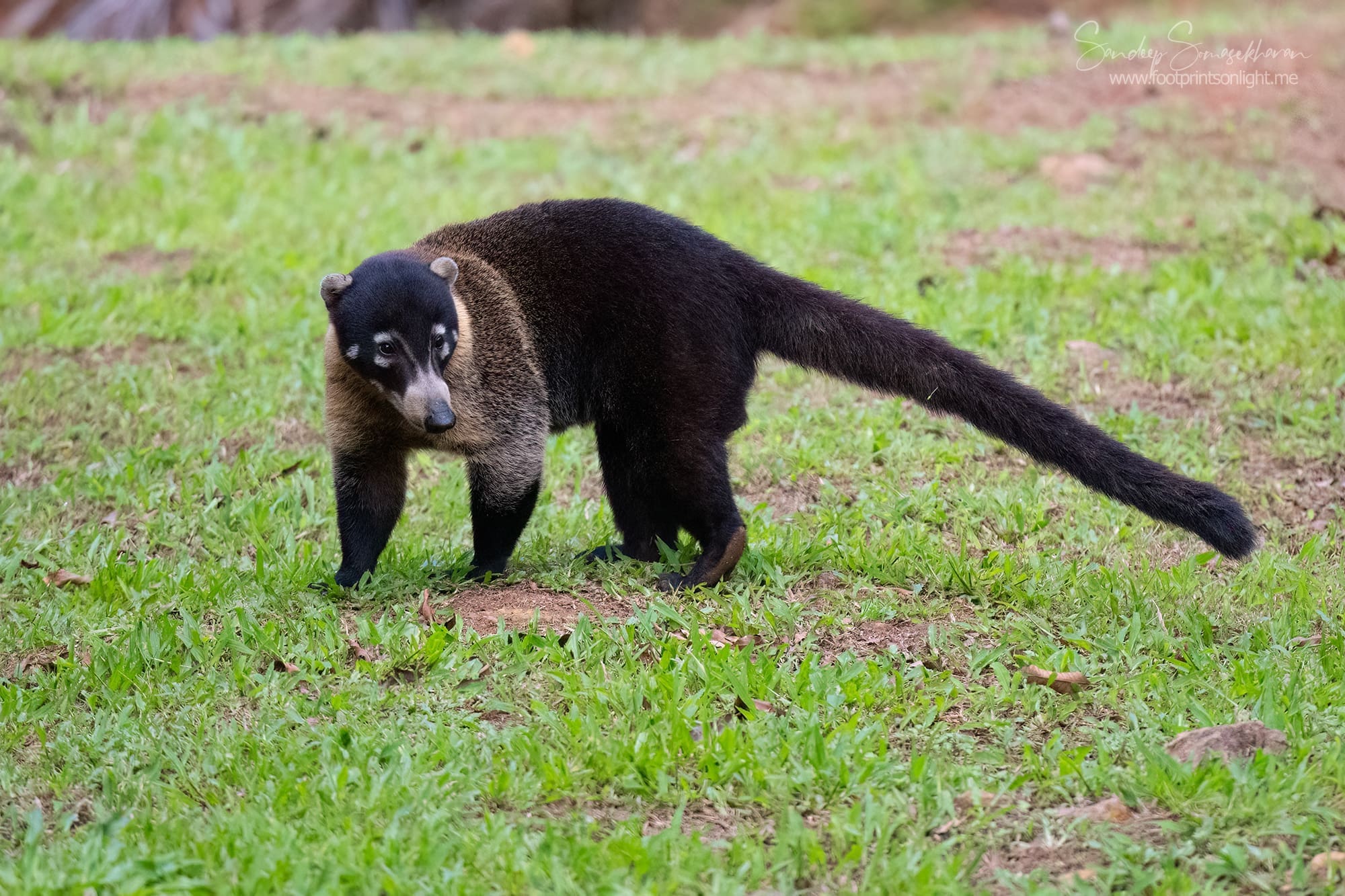
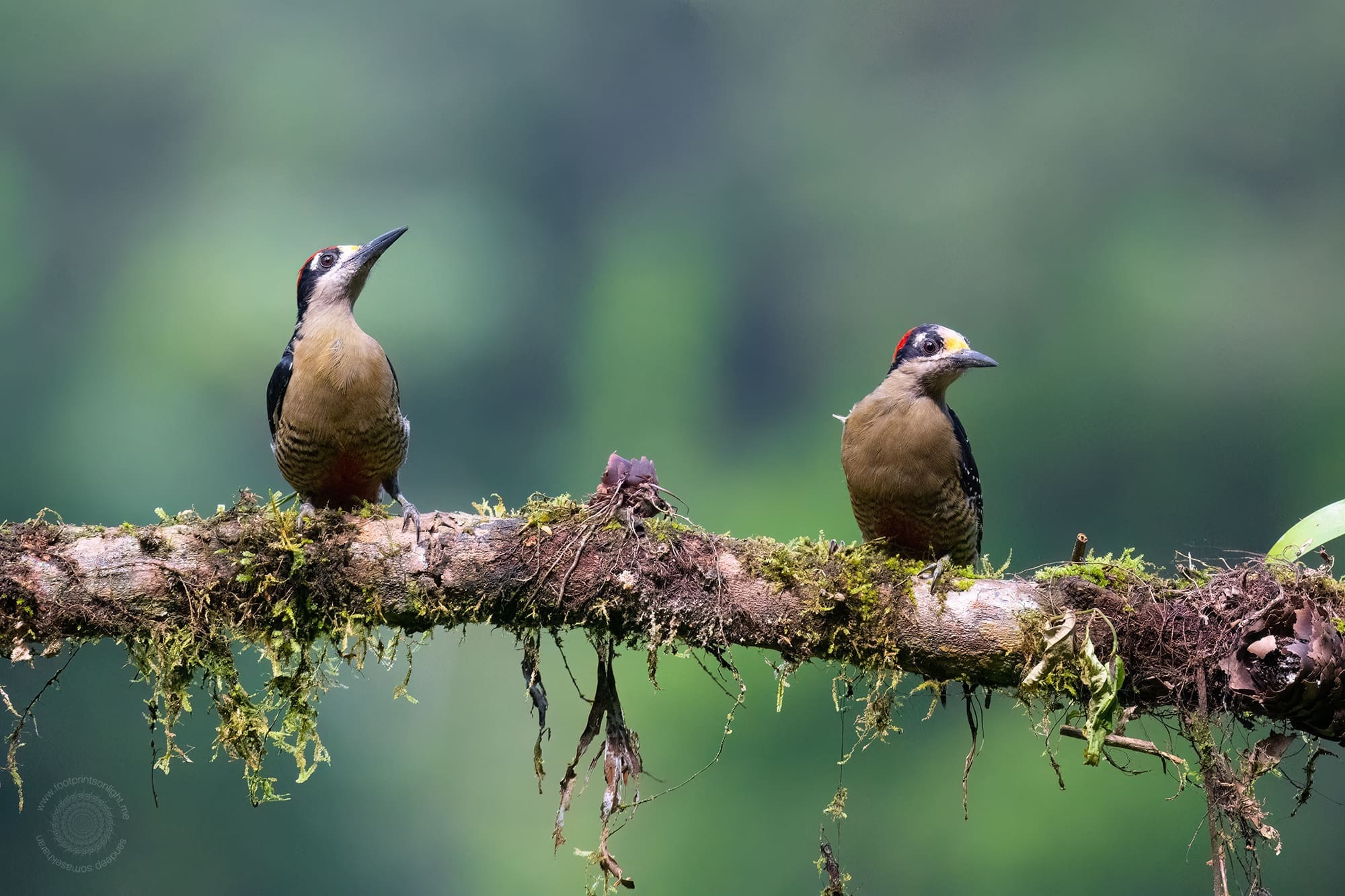
The way from Edward’s home is unpaved and steep, and Orlando’s Toyota has to pull out every bit of traction it can muster to haul us onto the main road. Back at the resort, we nap a bit and then get out around 4. We do a bit of birding around the resort and spot a Tropical Kingbird (Tyrannus melancholicus), a Wood-thrush (Hylocichla mustelina) and a Yellow-bellied Flycatcher (Empidonax flaviventris).
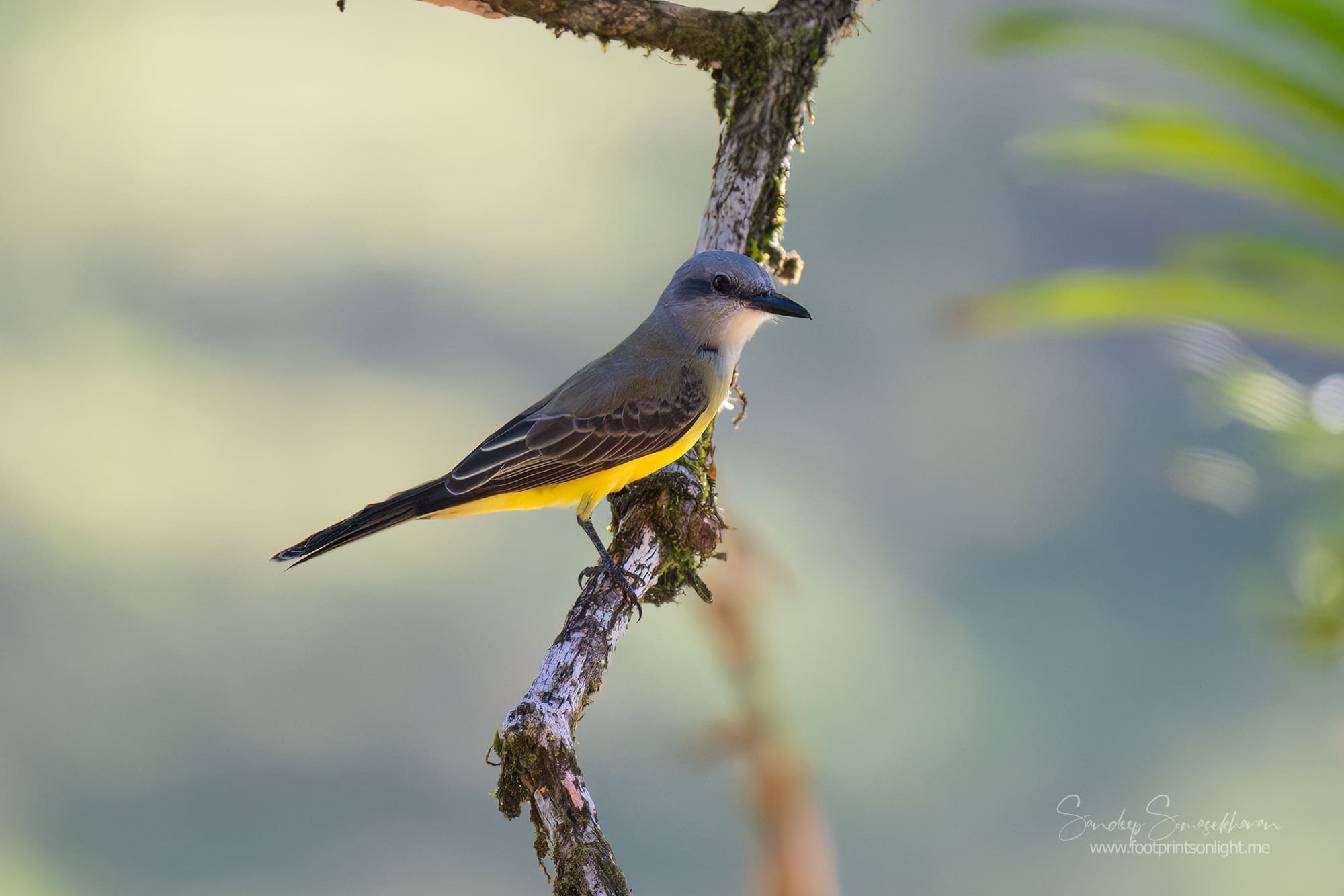
Back at El Pizote, the feeders are empty and we head to another spot in the hope of spotting some raptors. As we pile into the Toyota, a pair of toucans descend on the feeder. We are a little dismayed at this development, but decide to go ahead with our plan for checking out raptors, as going back to the feeders may spook the toucans. This time the Toyota is unable to climb, and starts rolling backwards. Orlando once again comes to the rescue, floors the accelerator and pulls us out into the main road. We all burst into applause. “Yay Baby!” says Edward, patting the dash.
About three miles away, we approach Edward’s new property, which he is developing currently. A cliff overlooking a small valley has been cleared out and a couple of sheds are being constructed there. Just outside it, we spot a Gray Hawk (Buteo plagiatus) perched beside the road, but by the time we pull up, the bird flies off to a tree. We get a couple of shots, and climb back in.
Once in the property, Edward points us to a palm tree, where a pair of Yellow-headed Caracaras (Milvago chimachima) come to roost. As we come to the edge of the property, something takes off from the trees on the other side of the valley. “Laughing Falcon (Herpetotheres cachinnans)“, says Edward. We manage a couple of shots, even though the bird is silhouetted against the evening sky.
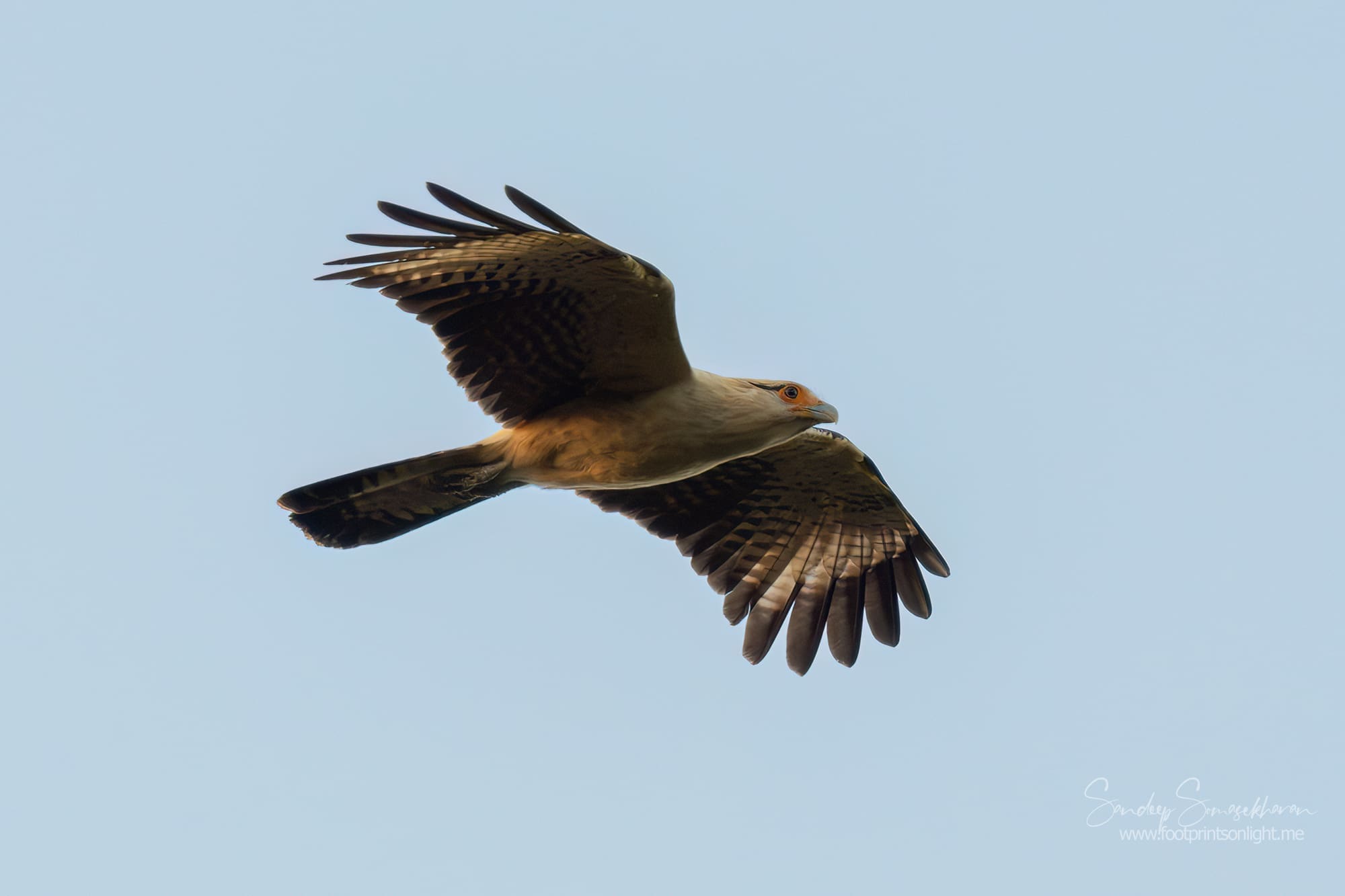
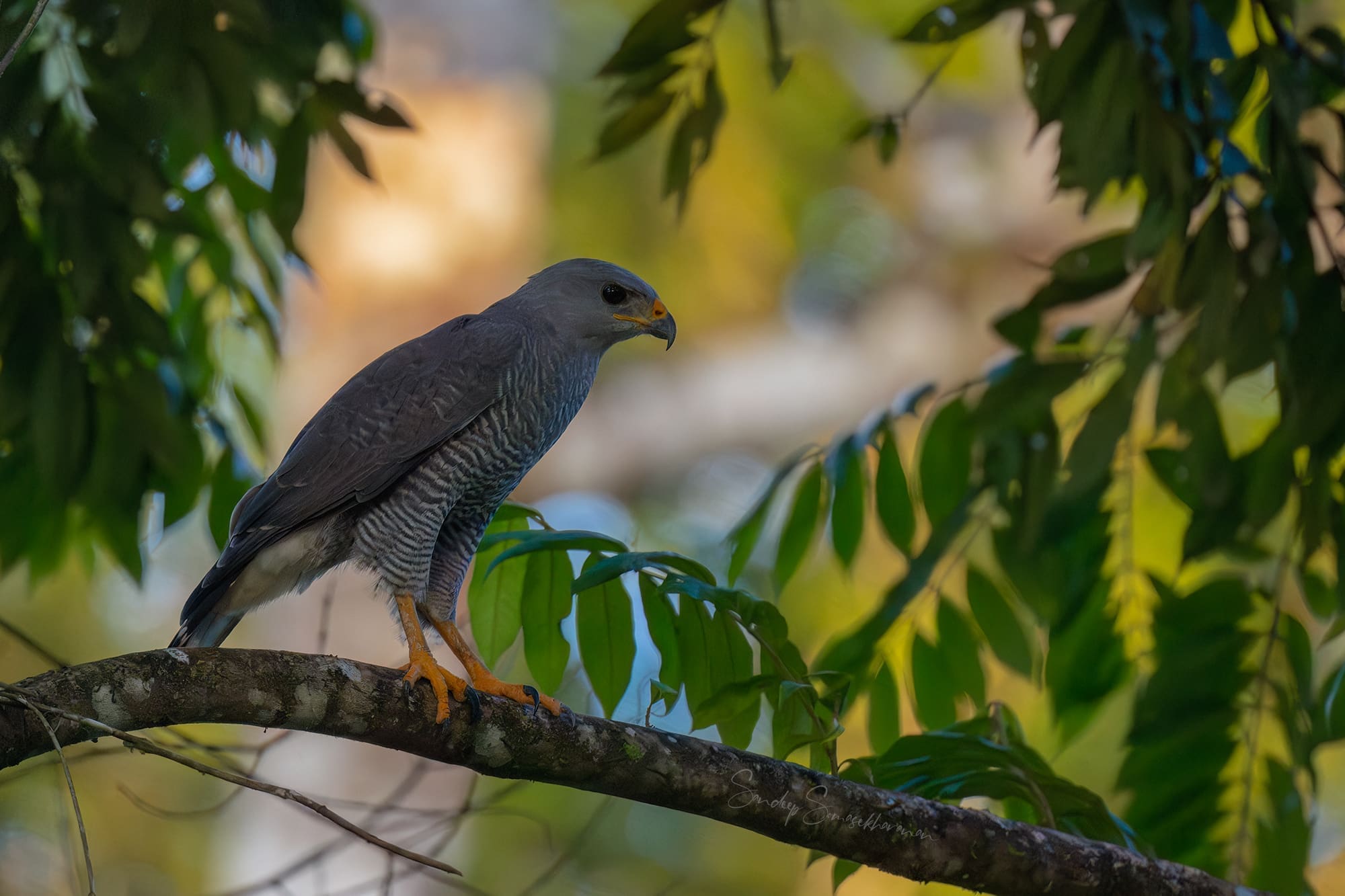
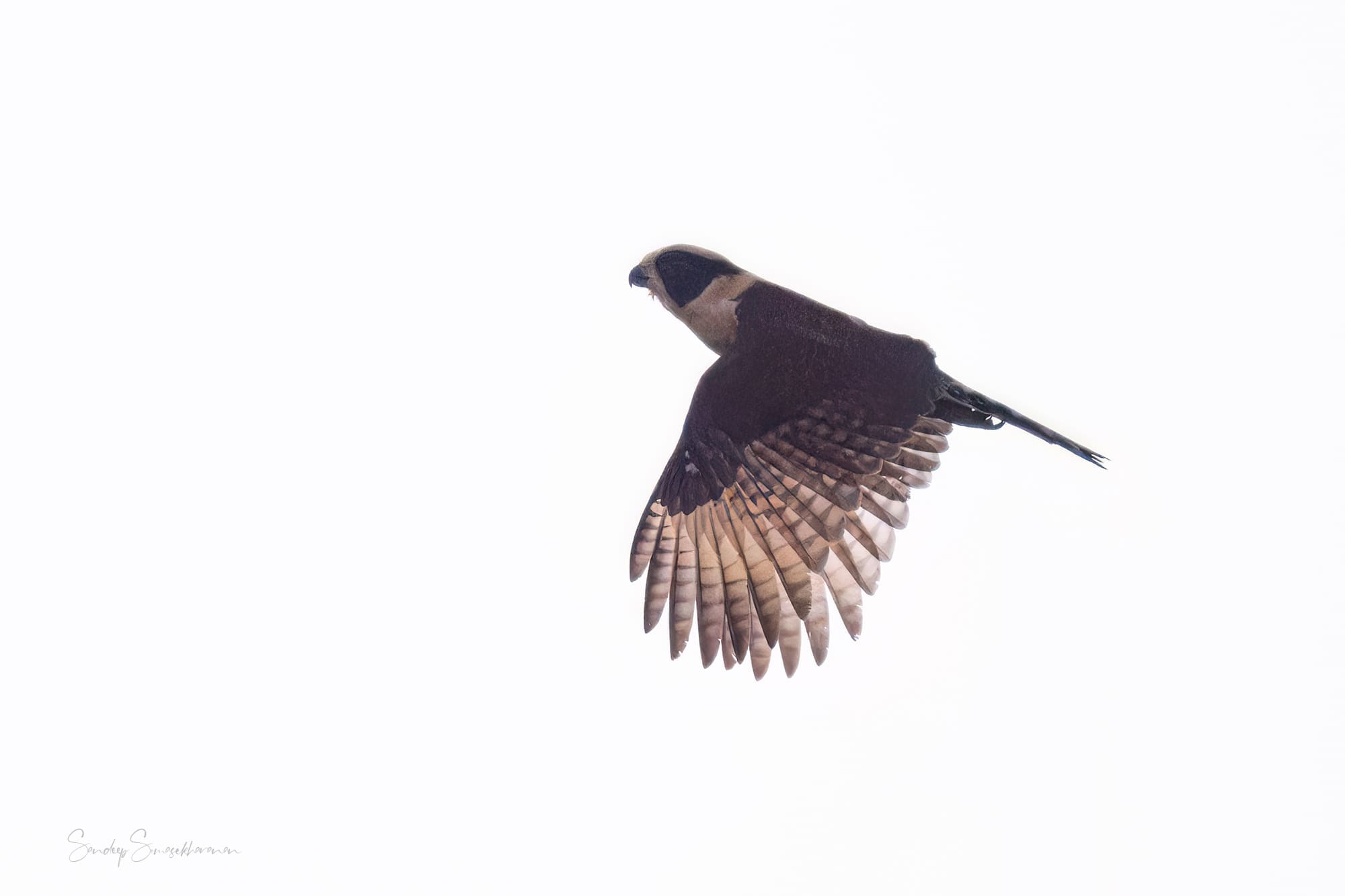
Soon, we hear harsh cries and spot three Scarlet Macaws (Ara macao) circling the property. They do not come anywhere near us, so we don’t get great shots, but we are happy that we got a glimpse of them. Soon afterwards. we see a pair of Great Green Macaws (Ara ambiguus), a Critically Endangered species. There is a pair of Montezuma Oropendolas (Psarocolius montezuma) and Red-lored Parakeets (Amazona autumnalis) that fly by, and the light starts fading even more.
We head back to El Pizote. On the way, Edward spots a Scarlet Macaw descending onto a tree and asks Orlando to stop. And, sure enough, we have a huge macaw gnawing away at the tree trunk. Even though this bird was a good 150 meters away, its size is breathtaking. In low light, we manage a few shots and, after dropping off Edward, head back to our rooms.
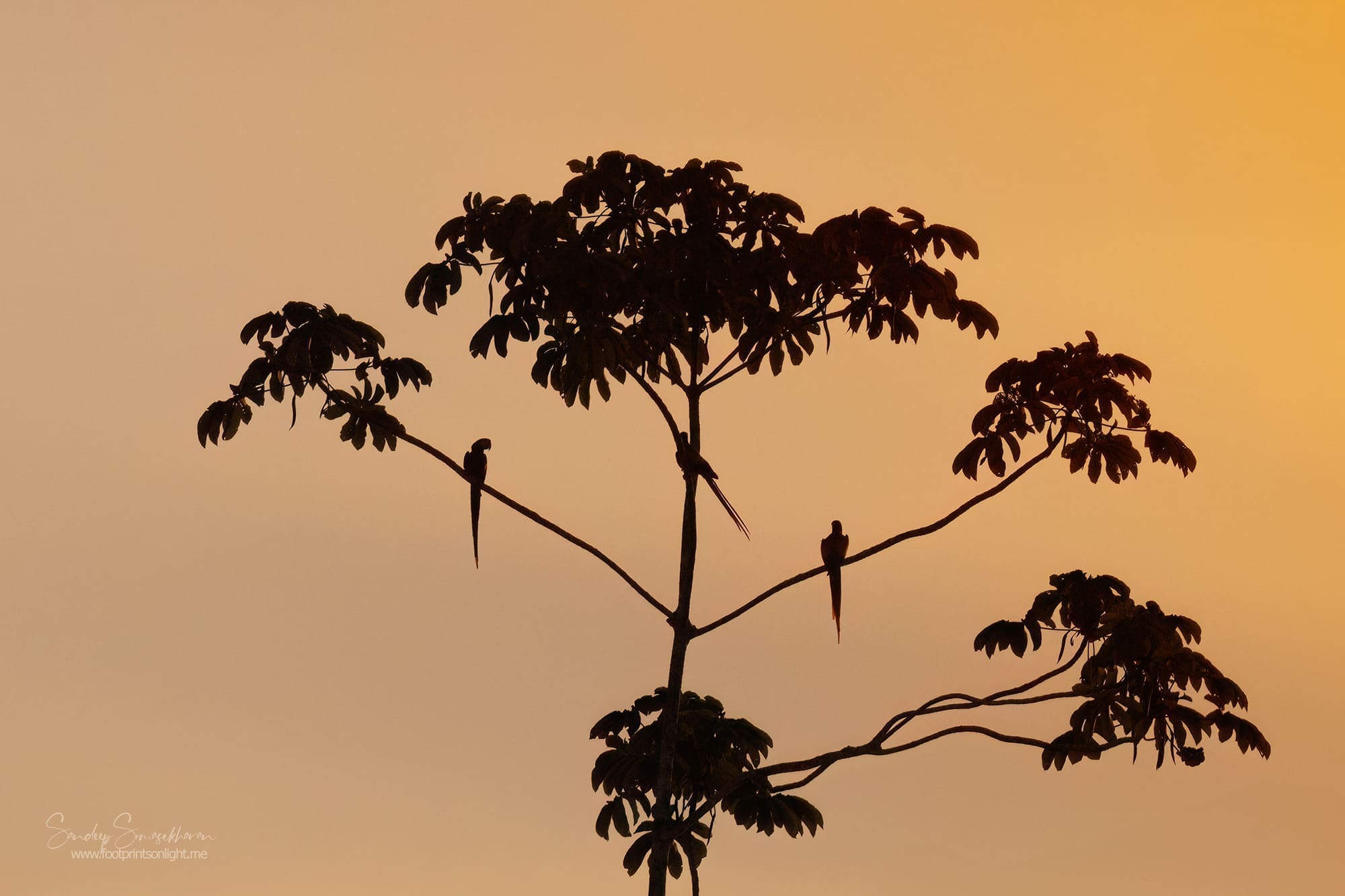
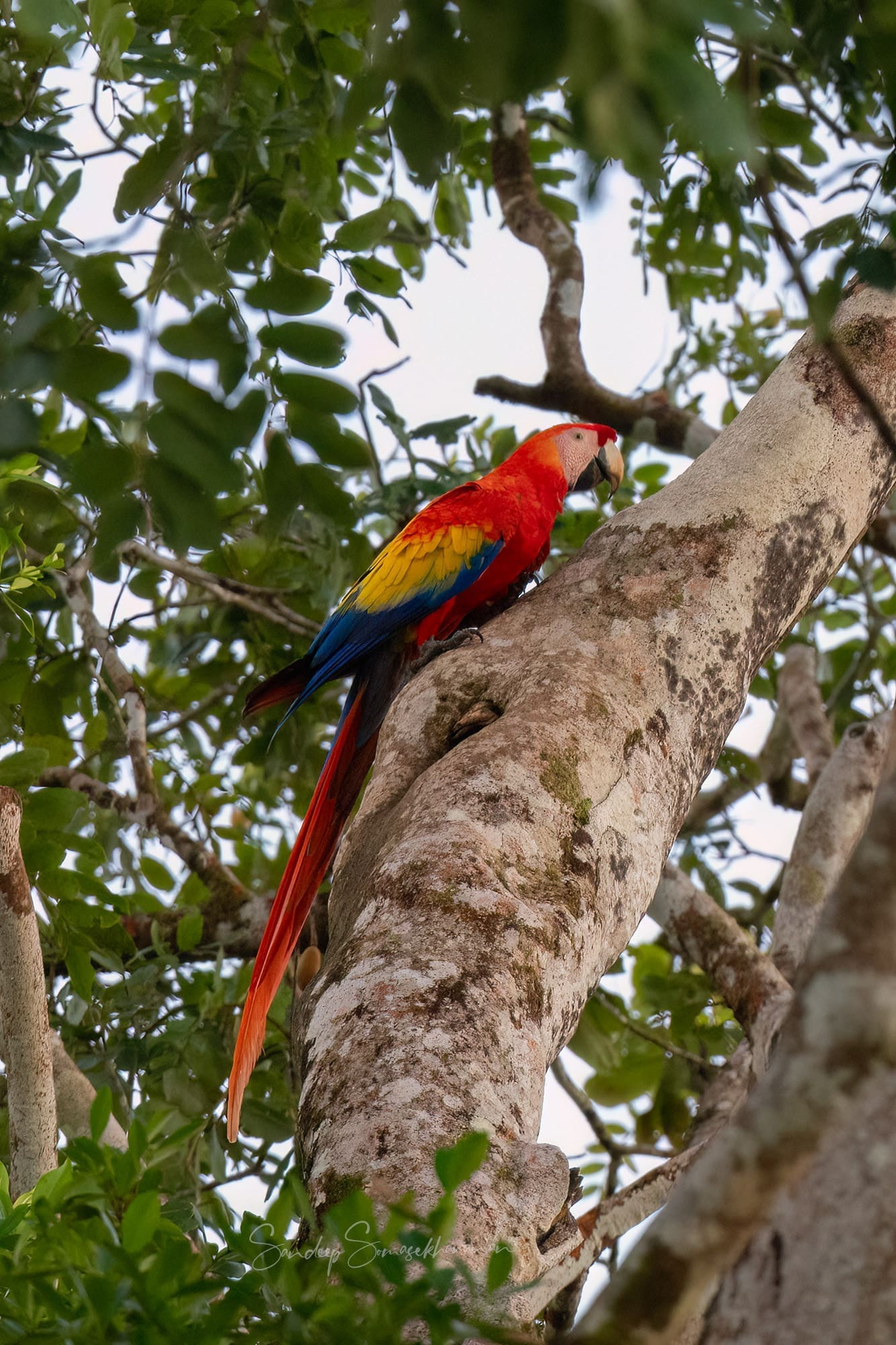
Orlando promises to come at 7 and we return to our rooms to freshen up. I open the bathroom and a bat takes off from the roof of the toilet, flutters a bit, and escapes into the open air above the shower. It feels a bit unnerving to be showering in the open, but I am grimy and sweaty all over, and I embrace nature in the primal sense. After a change of clothes, I step out, surprised that for the first time, we do not see Orlando waiting for us. We call him on his cell and he lets us know that the “van is broken”. We decide to hike up the hill to get to the cafeteria for dinner. It is a pleasant walk, and the weather is mild. When we get there, we see Orlando and his trusty van, this time on three wheels and resting on a jack. Orlando says that the wheel got punctured and someone from the town was coming up to get it fixed. He apologizes profusely for the inconvenience, but we let him know that the walk was quite enjoyable and was no trouble.
Our dinner is soon ready. Ericka is there, all smiles, serving us and answering our questions. She is the only person, apart from the cooks in the kitchen, who is running the place. The grilled chicken was easily the best I have ever had – tender, with a very plain but delectable marinade. There is something else on the plate that again takes me back to my childhood – yucca (tapioca/cassava) root cut into cylinders and steamed. The taste of the butter-soft yucca brought back memories from childhood when, on Saturdays, my mom would serve steamed yucca with a dip made of pearl onions and chillies crushed into coconut oil. Dessert follows — brownie with vanilla ice cream.
A tiny chihuahua wandering around the cafeteria begs to be petted but never for scraps. Spooked by something in the trees, she begins to bark loudly. “Reina, quiet!” calls out Ericka while she shuttles from the kitchen and the tables serving food, but Reina does not heed. We point our powerful flashlights to the trees but are unable to find what she is barking at. After dinner, we notice that Orlando has the company of a repairman. We go over to say goodnight, and Orlando shows us a nail that has punctured the wheel; evidently from Edward’s property where there was construction going on. We thank him and walk down to the cottages, once again feeling content, both our tummies and memory cards chock-full.
Our Christmas Day was truly made by a bunch of people who put our comfort and happiness ahead of their family time.
Coming up in Part 4 – Midnight weightlifting, flashing hummingbirds, and misgendering in Spanish
- Costa Rica Diaries – Parting Gifts - May 5, 2024
- Costa Rica Day 6 – Resplendent Quetzal: Part Bird, Part God and Full-Time Economy Driver - April 17, 2024
- Costa Rica Day 5 – Toucan Trees and Wild Dreams Coming True - March 22, 2024

